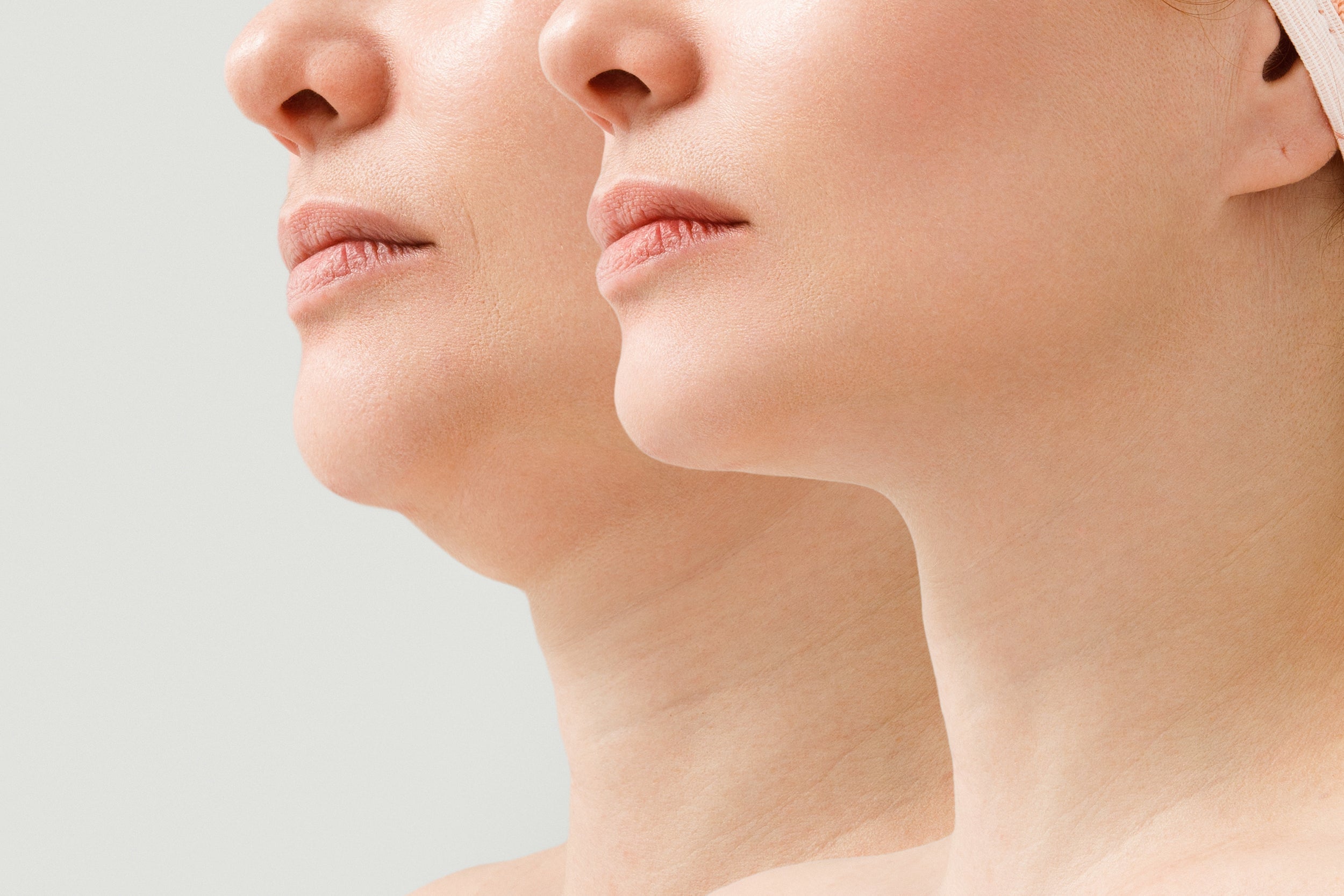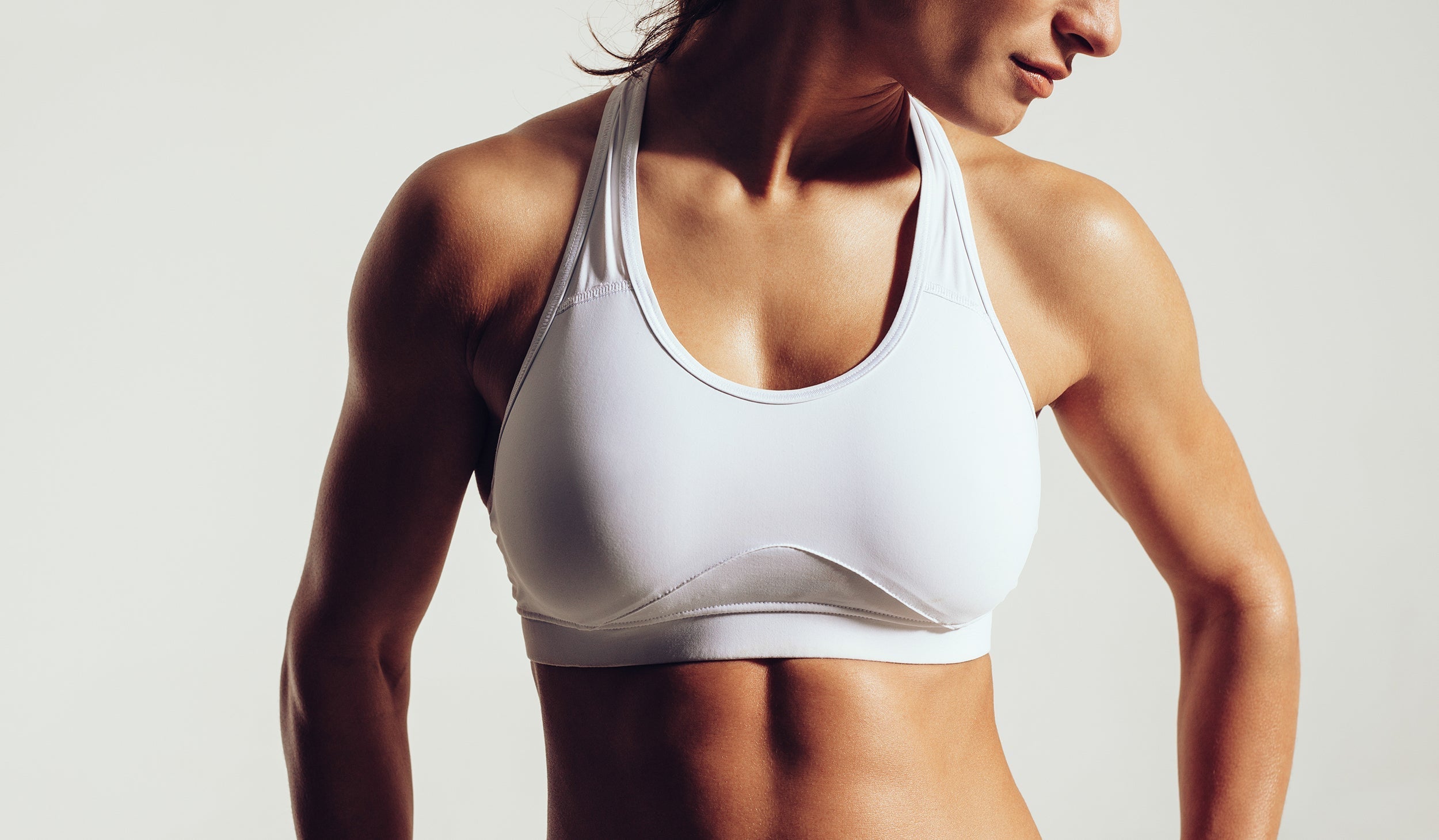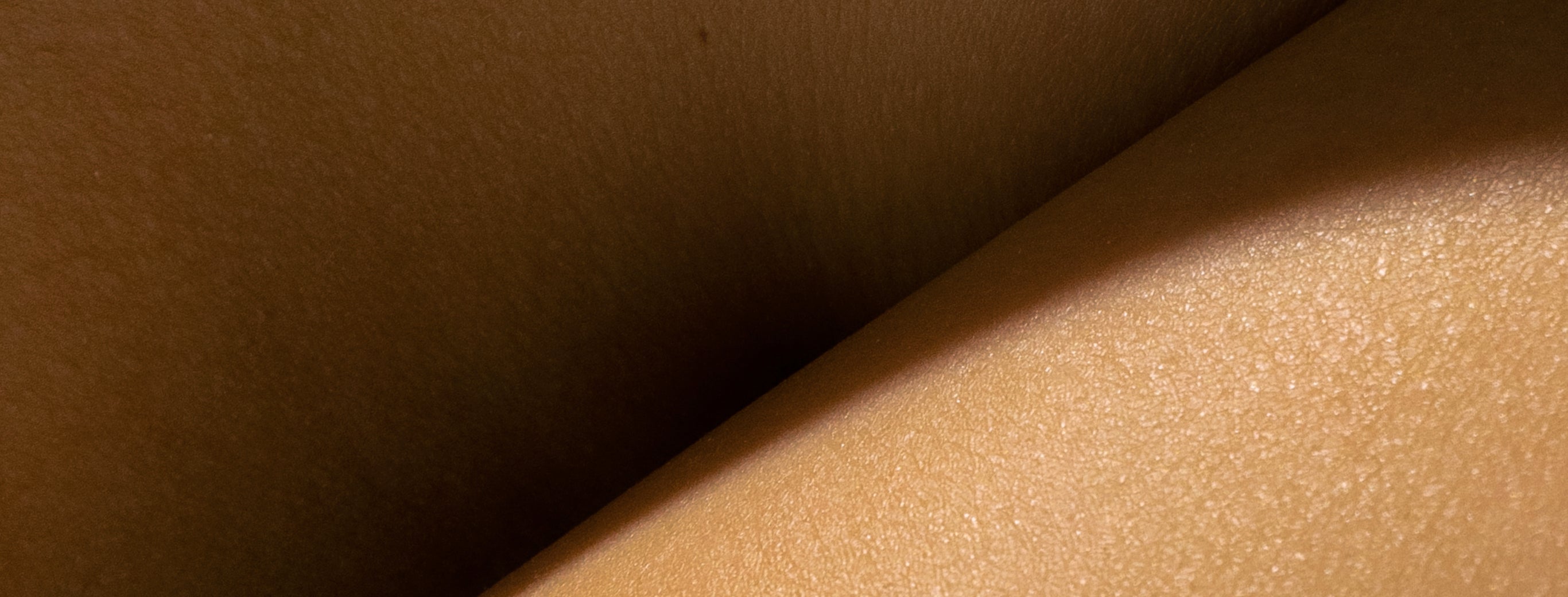Swelling After Fat Transfer to Face: What to Expect and How to Get Relief

Three days post-fat transfer, you're expecting to see the subtle facial rejuvenation you invested in. Instead, you look like someone inflated your face with a bicycle pump and forgot to stop. Your cheekbones have disappeared into puffiness. Your jawline is nowhere to be found. And you're starting to panic that maybe—just maybe—something went terribly wrong.
Here's the truth bomb nobody drops before facial fat transfer: that puffy situation in the mirror isn't a complication. It's not over-correction. It's not your surgeon's mistake. It's the completely predictable biological response to one of the most complex procedures in cosmetic surgery—one where success depends entirely on how well your body handles the swelling and integration process over the coming months.
Unlike breast augmentation where implants just need space to settle, or a tummy tuck where you're removing excess, facial fat transfer asks your body to perform biological magic: take fat cells from one location, relocate them to your face, and keep them alive long enough to establish new blood supply in completely foreign territory. That swelling you're seeing? It's your body working overtime on the most important construction project of your recovery.
This guide reveals what's really happening behind that puffiness, why facial fat transfer swelling behaves differently than every other cosmetic procedure, and the evidence-based strategies that determine whether your transferred fat thrives or merely survives.
The Biological Battle Happening Beneath Your Skin
Facial fat transfer swelling isn't just inflammation—it's the visible evidence of a sophisticated biological negotiation where your immune system decides which transferred fat cells get to stay and which don't make the cut.
The Relocation Survival Game
Think of transferred fat cells like astronauts landing on a new planet. They arrive with limited oxygen reserves and a tight deadline to establish connections with the local infrastructure (your blood vessels) or they perish. During those first 48-72 hours, every transferred fat cell is racing against time to extend tiny vascular connections into your existing facial tissue.
Your body floods the area with inflammatory cells that serve dual purposes: they protect against infection while simultaneously facilitating or blocking fat cell integration based on complex signals. The swelling you're experiencing is the physical manifestation of this massive cellular reorganization—thousands of fat cells either successfully integrating or being marked for elimination, all happening simultaneously across your face.
Why Faces Swell Differently Than Bodies
Your face contains proportionally more blood vessels per square inch than almost anywhere else on your body. This vascular density is excellent news for fat graft survival rates (more potential connection points), but it means inflammatory responses appear dramatically more obvious than identical procedures performed elsewhere.
The architectural structure of facial tissues amplifies this effect. Unlike your abdomen or thighs where thick layers of tissue can hide swelling, your facial skin sits directly above minimal fat padding and intricate muscle networks. There's essentially nowhere for fluid accumulation to hide, which is why even moderate swelling creates such dramatic visible changes.
Facial expressions compound the challenge. Every time you talk, smile, or chew, you're activating muscles that affect swollen tissues—creating the phenomenon where your face can look significantly different depending on whether you're animated or at rest.
The Injection Pattern Impact
Here's what most patients don't realize: the specific injection technique your surgeon uses creates distinctive swelling patterns. Microdroplet techniques (many tiny deposits) create more diffuse, even swelling that resolves relatively uniformly. Bolus injections (fewer, larger deposits) may create localized areas of more intense puffiness that take longer to integrate.
Multi-layer fat grafting—where fat is placed at different tissue depths—creates complex swelling patterns as each layer responds independently. Surface layer fat often shows more immediate swelling but faster resolution, while deeper grafts may maintain internal puffiness even after superficial swelling subsides.
The Swelling Stages Nobody Warns You About
Facial fat transfer recovery follows predictable biological phases, but each stage presents unique challenges that differ dramatically from other cosmetic procedures.
Days 1-4: The Acute Integration Crisis
This isn't just peak swelling—it's the biological make-or-break window where fat cell survival gets determined. Your face looks its absolute worst during this phase precisely because your body is working its hardest.
⏰ THE 72-HOUR FAT CELL SURVIVAL WINDOW
Your transferred fat cells are on a strict biological deadline:
-
Hours 0-24: Critical vascular connection initiation begins. Fat cells release signaling molecules seeking nearby blood vessels.
-
Hours 24-48: Peak blood supply establishment period. Successful cells form initial capillary connections; unsuccessful cells begin showing signs of distress.
-
Hours 48-72: Integration success or failure becomes determined. Cells with adequate blood supply stabilize; those without begin the reabsorption process.
Bottom line: Your nutrition, positioning, and care choices during this 72-hour window directly impact what percentage of transferred fat survives permanently. This is why pre-surgical nutritional preparation matters—your tissues need optimal nutrient reserves before this critical period begins.
The Cellular Drama: Transferred fat cells are frantically attempting to establish blood supply while your immune system simultaneously floods the area with inflammatory mediators. This creates a temporary biological traffic jam where fluid accumulation reaches maximum levels as your vascular system tries to deliver oxygen and nutrients to thousands of transplanted cells.
What You're Actually Seeing: Not just swelling, but active tissue remodeling. Those lumpy, uneven areas? That's normal architectural adjustment as fat integrates. The asymmetry? Different facial regions have varying vascular density, so integration happens at different speeds. The firmness? That's protective edema cushioning vulnerable fat grafts.
The Critical Mistake: Many patients see this dramatic swelling and panic, assuming over-correction. They might apply excessive cold therapy directly to injection sites (potentially compromising fat cell survival) or aggressively massage areas trying to "distribute" the swelling (potentially disrupting fragile vascular connections forming between transferred fat and your tissue).
Days 5-10: The Deceptive Improvement Window
Swelling decreases noticeably during this phase, creating false hope that you're almost done. You're not. You're transitioning from acute crisis to chronic remodeling, which follows entirely different rules.
The Biological Transition: Acute inflammatory cells (neutrophils and early macrophages) are being replaced by chronic repair cells (fibroblasts and mature macrophages). Fat cells that successfully established initial blood supply are now building more robust vascular networks, while unsuccessful grafts are being marked for elimination and gradual reabsorption.
The Visibility Trap: Your face looks significantly better compared to days 1-4, leading many patients to assume they're 70-80% healed. In reality, you're maybe 30-40% through the actual integration process. The majority of transferred fat is still in a vulnerable state where improper care could compromise final survival rates.
What Distinguishes This Phase: Unlike other procedures where decreased swelling signals accelerating healing, facial fat transfer swelling reduction during this window doesn't necessarily correlate with faster final results. Some patients with persistent mild swelling achieve better long-term fat retention than those whose swelling resolves quickly.
Weeks 2-6: The Reabsorption Reality Check
This phase brings the emotional gut-punch: after swelling decreases, you'll notice your volume decreasing too as your body naturally reabsorbs 20-40% of transferred fat. This is normal, expected, and exactly why experienced surgeons intentionally over-correct.
The Biological Sorting: Your body has completed its preliminary assessment of which fat cells successfully integrated and which didn't. The unsuccessful grafts undergo apoptosis (programmed cell death) and gradual reabsorption. Inflammatory cells arrive to clean up cellular debris, which can temporarily increase localized swelling in specific areas even as overall puffiness decreases.
The Psychological Challenge: Watching volume you paid for literally disappear from your face creates understandable anxiety. This is where understanding the biology helps: the fat you're losing was never going to survive long-term anyway. What remains represents your permanent result—fat cells that successfully established blood supply and integrated into your facial architecture.
The Intervention Window: This phase represents your last opportunity to optimize final fat retention through nutrition, lifestyle, and avoiding behaviors that compromise remaining grafts. Choices you make during weeks 2-6 can influence whether you end up at the low end (60% retention) or high end (80% retention) of typical survival rates.
Months 2-4: The Architecture Settling Period
The drama is over, but subtle changes continue as integrated fat cells mature and facial tissues adapt to their new architecture. This period separates good results from exceptional ones.
The Maturation Process: Successfully integrated fat cells are transitioning from survival mode to normal function. They're establishing permanent positions within your facial tissue matrix, developing mature fat cell characteristics, and beginning to respond to your body's normal metabolic signals.
The Skin Adaptation Factor: Here's what most discussions miss: your facial skin is simultaneously adapting to its new underlying volume. Skin elasticity, collagen remodeling, and dermal architecture adjustment all occur during this window. These changes affect how smoothly your results appear and how naturally the transferred fat integrates with surrounding tissues.
Why This Phase Matters: Patients who maintain optimal nutrition and avoid weight fluctuations during this period often achieve more natural, longer-lasting results than those who neglect these factors once obvious swelling resolves.

Management Strategies Specific to Fat Transfer Biology
Generic swelling management doesn't work for facial fat transfer because you're not just reducing inflammation—you're trying to optimize fat cell survival while managing swelling. These goals sometimes conflict, requiring strategic decision-making.
🚦 RED LIGHT / GREEN LIGHT: PROTECTING YOUR FAT GRAFTS
🟢 GREEN LIGHT - Safe & Beneficial:
✓ Cool compresses to temples, forehead edges, and upper neck (away from injection sites)
✓ Sleeping elevated at 35-40 degrees on your back
✓ Short, gentle walks (5-10 minutes) every 2-3 hours
✓ Anti-inflammatory whole foods (fatty fish, leafy greens, berries)
✓ Consistent hydration with electrolytes (8 oz every 2-3 hours)
✓ Before + After Vitals for therapeutic nutritional support
✓ Gentle upward stroking movements (after week 2, with surgeon approval)
🔴 RED LIGHT - Risks Fat Cell Survival:
✗ Direct ice application to injection sites (causes vasoconstriction that starves fat cells)
✗ Side sleeping or face-down positions during first 3-4 weeks
✗ Aggressive facial massage or manipulation during first 2 weeks
✗ Nicotine exposure of any kind (reduces blood supply by 30-40%)
✗ Alcohol consumption (dilates vessels and impairs healing)
✗ Intense cardiovascular exercise before clearance
✗ Excessive heat exposure (hot showers, saunas, heating pads on face)
The Critical Difference: Standard post-surgical advice says "ice everything." For fat transfer, that's potentially disastrous. Your transferred fat cells need robust blood flow to survive—anything that constricts blood vessels threatens their integration.
The Cold Therapy Paradox
Standard advice says ice everything. For fat transfer? That's potentially disastrous. Direct cold application to injection sites can compromise blood supply to vulnerable fat cells, reducing survival rates. Yet excessive inflammation also threatens fat integration.
The Solution: Apply cooling strategically to peripheral areas (temples, forehead edges, upper neck) where you can reduce overall facial inflammation without directly affecting grafted fat. Use brief intervals (10-12 minutes maximum) at temperatures that are cool but never freezing. The goal is reducing systemic inflammatory response without creating localized vasoconstriction at graft sites.
The Elevation Equation
Yes, sleep elevated—but understand why it matters specifically for fat transfer. Elevation isn't just about reducing swelling through gravitational drainage. It's about maintaining optimal blood pressure and flow dynamics to support fat cell integration.
The Precision Approach: Maintain 35-40 degrees of elevation (not the standard 45 degrees recommended for other procedures). This angle optimizes venous drainage without reducing arterial pressure below the threshold needed for robust blood supply to integrating fat grafts. Too much elevation can be as problematic as too little.
The Movement Paradox
Gentle activity activates lymphatic drainage and reduces swelling—but excessive movement or cardiovascular stress can compromise fat integration by redirecting blood flow away from facial tissues toward active muscles.
The Strategic Balance: Short, frequent, gentle walks (5-10 minutes every 2-3 hours) provide lymphatic benefits without cardiovascular stress. Avoid sustained activity that elevates your heart rate above resting levels during the first two weeks. Your fat cells need your body's full metabolic attention focused on facial integration, not competing with exercise demands.
The Massage Timing Controversy
Some surgeons recommend early gentle massage; others prohibit all manipulation. The truth? Timing determines whether massage helps or harms.
The Evidence-Based Timeline: Avoid all direct manipulation during days 1-7 when vascular connections are most fragile. Begin extremely gentle upward stroking movements during weeks 2-3 if cleared by your surgeon, focusing on encouraging fluid drainage rather than redistributing fat. Never apply direct pressure to grafted areas during the first month.
The Nutrition Factor in Fat Cell Survival
Here's what distinguishes facial fat transfer from other cosmetic procedures: nutrition doesn't just affect how fast you heal—it directly determines what percentage of your transferred fat survives permanently. The biological demands of keeping transplanted fat cells alive create unique nutritional requirements that standard post-surgical advice doesn't address.
The Vascular Development Demand
Fat cell survival depends entirely on rapid blood vessel formation. This process (angiogenesis) requires specific nutrients at levels far exceeding normal dietary intake. Your body is essentially building thousands of new tiny blood vessels across your face during a compressed timeline—a construction project with zero margin for missing materials.
Inadequate nutrition during this window doesn't just slow healing; it actively determines which fat cells get blood supply and survive versus which get reabsorbed. Think of it like a competition where fat cells with access to optimal nutrients win the survival lottery while undernourished cells lose.
The Critical Nutrients for Fat Integration
Vitamin C Requirements Skyrocket: Your body needs 5-10 times normal vitamin C levels to support the intensive collagen synthesis and blood vessel formation happening across your face. Standard dietary sources rarely provide therapeutic levels during this compressed timeline.
Protein Absorption Challenges: You might be eating adequate protein, but post-surgical digestive stress often prevents efficient absorption. Your body needs both sufficient protein intake AND the enzymatic support to actually utilize it for vascular construction.
Collagen Building Blocks: Specific amino acids and peptides signal your skin cells to increase natural collagen production, helping facial tissues adapt smoothly to new volume. Standard collagen supplements often lack the bioactive forms that trigger these cellular responses.
Digestive Health Protection: Anesthesia and pain medications disrupt gut function precisely when nutrient absorption matters most. Maintaining digestive balance ensures your body can access the nutrients you're providing.
Optimizing Your Nutritional Foundation
Focus on nutrient-dense whole foods including fatty fish rich in omega-3s, leafy greens packed with vitamin C and minerals, high-quality lean proteins, and colorful fruits providing antioxidants. However, achieving therapeutic levels through food alone proves challenging when appetite is suppressed and digestive function compromised.
This is where specialized post-surgical supplements designed specifically for cosmetic surgery become valuable. Sulinu's Before + After Vitals provides therapeutic dosages of enhanced vitamin C, proteolytic enzymes for protein absorption, hydrolyzed collagen, and digestive support—all in forms engineered for surgical recovery rather than general wellness. Begin 1-2 weeks pre-surgery and continue through the critical 6-8 week integration period.
Research demonstrates that patients optimizing pre-surgical nutrition experience 40% fewer complications and 30% fewer issues compared to those who don't—outcomes that directly affect both fat retention and final aesthetic results.
SHOP THE BEST SUPPLEMENT FOR SWELLING
What Actually Threatens Your Results
Certain behaviors specifically compromise fat graft survival beyond just worsening swelling:
Facial Pressure During Sleep: Side sleeping during the first 3-4 weeks can create pressure zones that compromise blood supply to grafted areas. This isn't just about aesthetics—it can reduce fat survival in pressure-affected zones by 15-20%.
Premature Facial Treatments: Aggressive facials, facial massage by untrained practitioners, or esthetic procedures during the first 3 months can disrupt fat integration. Even treatments that seem gentle can compromise grafts still establishing permanent positions.
Weight Fluctuations: Gaining or losing more than 5-10 pounds during the first 3-6 months affects transferred fat cells just like it affects your natural fat. Significant weight loss can reduce your results; excessive gain can create disproportionate facial fullness.
Smoking or Nicotine Exposure: Even second-hand smoke or nicotine patches compromise vascular development crucial for fat survival. Nicotine causes vasoconstriction that directly reduces blood supply to integrating grafts—potentially reducing survival rates by 30-40%.
The Social Reality of Facial Swelling
Unlike body procedures you can hide under clothing, facial swelling is front-and-center in every human interaction. This visibility creates unique psychological challenges that other procedures don't trigger.
The Mirror Obsession Trap
Facial fat transfer patients check their reflection more frequently than any other cosmetic surgery patients because changes are constantly visible. This creates an unhealthy hyperfocus where you notice every subtle fluctuation—many of which are completely normal but trigger disproportionate anxiety.
The Solution: Limit mirror checks to twice daily (morning and evening) in consistent lighting. Take weekly progress photos instead of daily ones. The changes happening week-to-week will be obvious in photos even when day-to-day variations seem minimal or confusing.
The Explanation Dilemma
People will notice your facial changes and ask questions—both during the swollen phase and after. Having prepared responses reduces stress and maintains your privacy boundaries.
Strategic Responses: "I had a cosmetic procedure and I'm healing exactly as expected" works for casual acquaintances. "My face is still swollen but my surgeon says everything looks perfect" reassures concerned friends without oversharing details. "I'm not discussing specifics, but thanks for asking" establishes clear boundaries with people who press for details you're not comfortable sharing.
The Comparison Trap
Social media and surgeon websites show final results—never the challenging middle phases you're experiencing. Comparing your week-two swelling to someone else's six-month results creates false narratives about your progress.
The Reality Check: Those dramatic before-and-after photos represent 6-12 months of healing compressed into a single image. The person in the "after" photo looked exactly like you do right now at some point during their journey. Your timeline is your timeline—comparison only creates unnecessary anxiety.
When Swelling Signals Real Problems
Most swelling after fat transfer to face is completely normal, but specific patterns require professional evaluation:
Progressive Asymmetry: Initial asymmetry is normal as different areas heal at different rates. However, asymmetry that develops or worsens after week 2-3—especially if accompanied by firmness, warmth, or discoloration—may indicate complications like fat necrosis or infection.
Hardened Areas: While some firmness is normal as swelling resolves, distinct hard lumps that don't soften with gentle pressure, feel different from surrounding tissue, or develop after initial healing may indicate issues requiring intervention.
Systemic Symptoms: Swelling accompanied by fever above 100.4°F, severe headaches, vision changes, or feeling generally unwell suggests possible infection or other complications requiring immediate evaluation.
Vascular Compromise Signs: Skin discoloration (especially white, dusky blue, or purple tones), extreme pain disproportionate to expected discomfort, or areas that feel unusually cold may indicate blood supply problems requiring emergency intervention.
Trust your instincts. If something feels fundamentally wrong beyond normal recovery discomfort, contact your surgeon immediately rather than waiting to see if it resolves.
Frequently Asked Questions About Swelling After Fat Transfer to Face
How does facial fat transfer swelling differ from other facial procedures?
Facial fat transfer creates uniquely complex swelling because you're managing both liposuction trauma at donor sites plus multiple injection sites across your face, each undergoing active fat cell integration. Unlike facelifts or fillers where swelling purely reflects healing, your swelling includes the active biological process of fat cells establishing blood supply. This means swelling patterns are less predictable and resolution timelines more variable than procedures involving purely structural changes.
Why does my face look so different from day to day?
Daily fluctuations reflect the complex biology of fat integration. Some variation comes from standard factors like sleep quality, sodium intake, and hydration. But facial fat transfer adds another layer: transferred fat cells releasing inflammatory mediators as they integrate, localized areas completing integration at different rates creating shifting volume patterns, and your lymphatic system's efficiency varying based on activity, positioning, and even stress levels.
Can I tell the difference between swelling and actual fat volume?
During the first 4-6 weeks, honestly, no—they're visually indistinguishable. Swelling creates an apparent volume that will decrease. But you're also experiencing intentional over-correction because surgeons anticipate 20-40% fat reabsorption. Only after 3 months, when integration completes and reabsorption stabilizes, can you see your actual permanent volume. Early assessment is essentially impossible and only creates anxiety.
What's the single biggest mistake patients make in managing facial fat transfer swelling?
Applying aggressive cold therapy directly to injection sites during the first week. Patients see dramatic swelling and instinctively want to ice everything down, but direct cold to grafted areas can compromise the blood supply to vulnerable fat cells. The second biggest mistake? Judging results before 3 months, when most visible changes actually represent temporary factors rather than your final outcome.
Does the amount of swelling predict how much fat will survive?
Not reliably. Some patients develop dramatic swelling yet achieve excellent fat retention. Others have relatively modest swelling but lower survival rates. Swelling severity depends more on your individual inflammatory response patterns and the specific injection technique used than on how successfully fat integrates. The two processes are related but not directly correlated.
How do I know if I'm part of the 20-40% who loses more fat?
You won't know until 3-6 months post-procedure when reabsorption completes and your permanent result becomes apparent. However, optimizing nutrition, avoiding pressure on grafted areas, maintaining stable weight, and eliminating nicotine exposure can help push you toward the higher end (60-80% retention) versus lower end (40-60% retention) of typical survival ranges.
When can I resume normal skincare and facial treatments?
Most surgeons clear basic gentle cleansing and moisturizing within a week, but aggressive products (retinols, acids, scrubs) typically remain off-limits for 4-6 weeks. Professional facial treatments should wait at least 3 months until fat grafts fully integrate. Even then, inform your esthetician about your procedure so they can modify pressure and techniques around grafted areas.
Can supplements really affect how much transferred fat survives?
Yes—research demonstrates that targeted nutritional support significantly impacts fat graft survival rates because the integration process depends entirely on rapid blood vessel formation, which requires specific nutrients at therapeutic levels. Optimizing nutrition doesn't guarantee perfect results, but inadequate nutritional support can actively compromise fat cell survival during the critical integration window when your body's demands far exceed normal dietary intake.
Why does my surgeon's approach to swelling management differ from what I read online?
Fat transfer techniques vary significantly between surgeons, creating different swelling patterns and requiring tailored management approaches. Surgeons using microdroplet techniques may recommend different protocols than those using bolus injections. Multi-layer grafting requires different care than single-plane transfers. Your surgeon's specific instructions should always supersede general online advice because they understand the unique characteristics of your particular procedure.
What's the real timeline for seeing my actual results?
Initial dramatic swelling: peaks days 2-4, significantly improved by week 2.
Active fat reabsorption: weeks 2-8, creating volume changes independent of swelling.
Tissue settling and maturation: months 2-6, with subtle refinements continuing.
True final result: 6-12 months when all biological processes complete.
Anyone showing you "after" photos taken before 6 months is showing you incomplete results that may still change substantially.
Medical Disclaimer
This content is provided for educational purposes only and should not be considered a substitute for professional medical advice, diagnosis, or treatment. Every facial fat transfer recovery is unique and depends on numerous factors, including surgical technique, volume of fat transferred, injection locations, individual healing characteristics, and adherence to post-operative instructions.
The information presented here represents general guidelines and should never replace the specific instructions provided by your plastic surgeon and medical team. Post-operative care protocols vary significantly between surgeons based on their preferred techniques and your individual circumstances. Always prioritize and follow your surgeon's specific guidelines over any general information found online.
If you experience concerning symptoms during your recovery period—including excessive or worsening swelling, signs of infection, severe pain, vision changes, skin color changes, or any symptoms that feel abnormal—contact your surgeon immediately or seek appropriate emergency medical care. Do not delay seeking professional medical evaluation based on information found in this or any other online resource.
The mention of specific products, supplements, treatments, or techniques in this article does not constitute medical advice or professional endorsement. Always consult with your healthcare providers before starting any new supplements, treatments, or significant changes to your recovery routine, as these may interact with prescribed medications or interfere with your healing process.
Surgical results and recovery experiences vary significantly among individuals. No article can guarantee specific outcomes, healing timelines, fat graft survival rates, or final aesthetic results. The best outcomes result from following your surgeon's specific instructions, maintaining realistic expectations, understanding the biological processes involved, and maintaining open communication with your medical team throughout your recovery journey.
Before + After Vitals
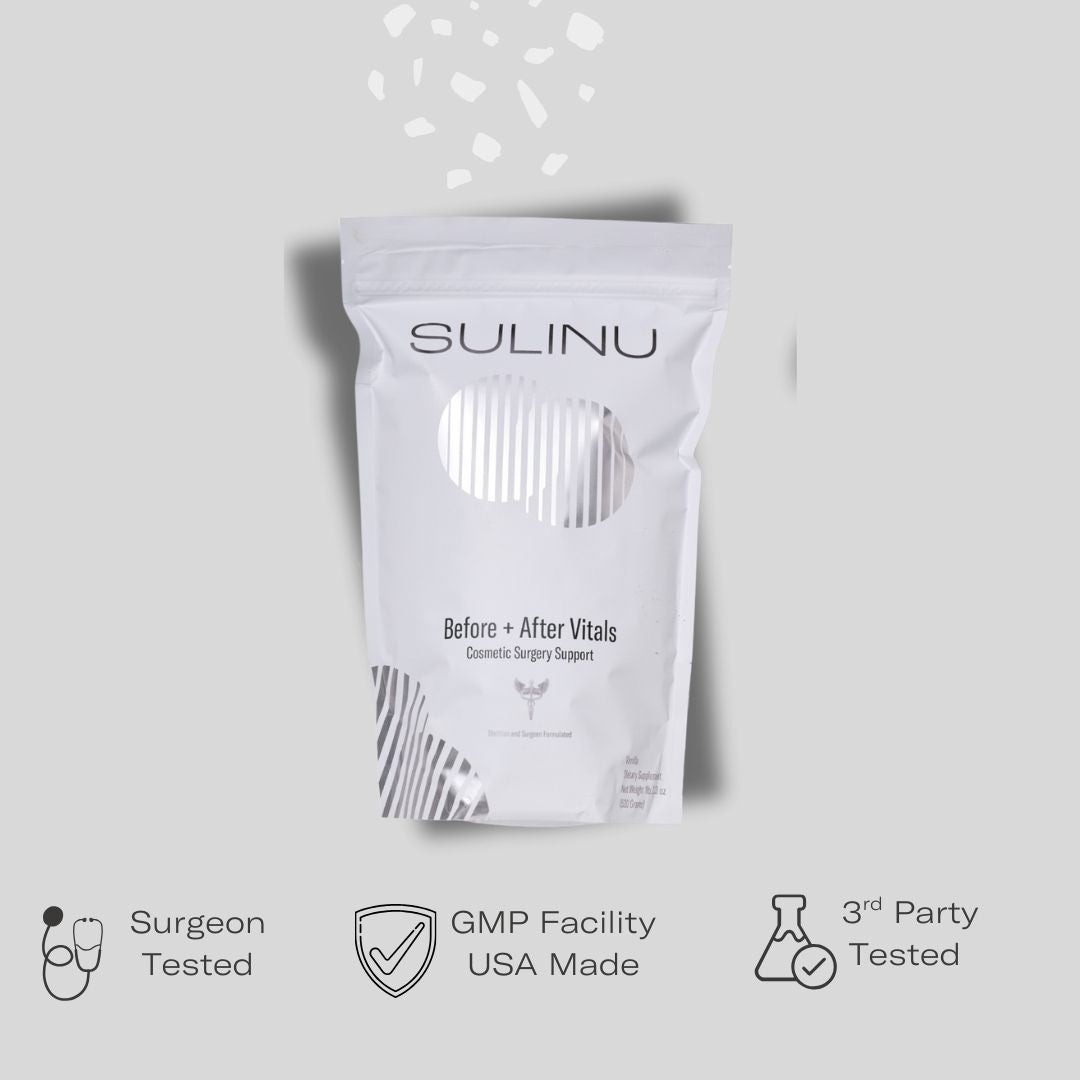
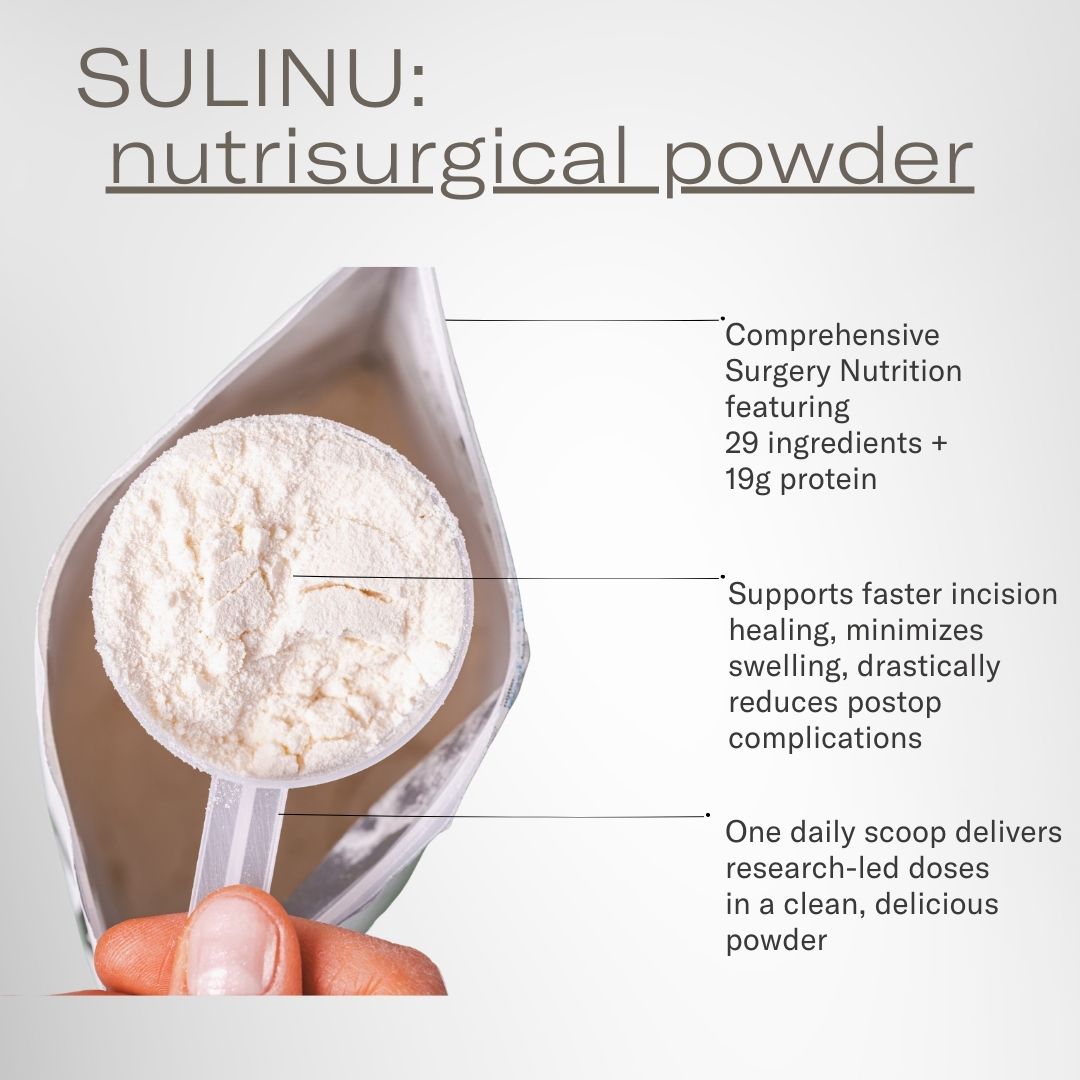
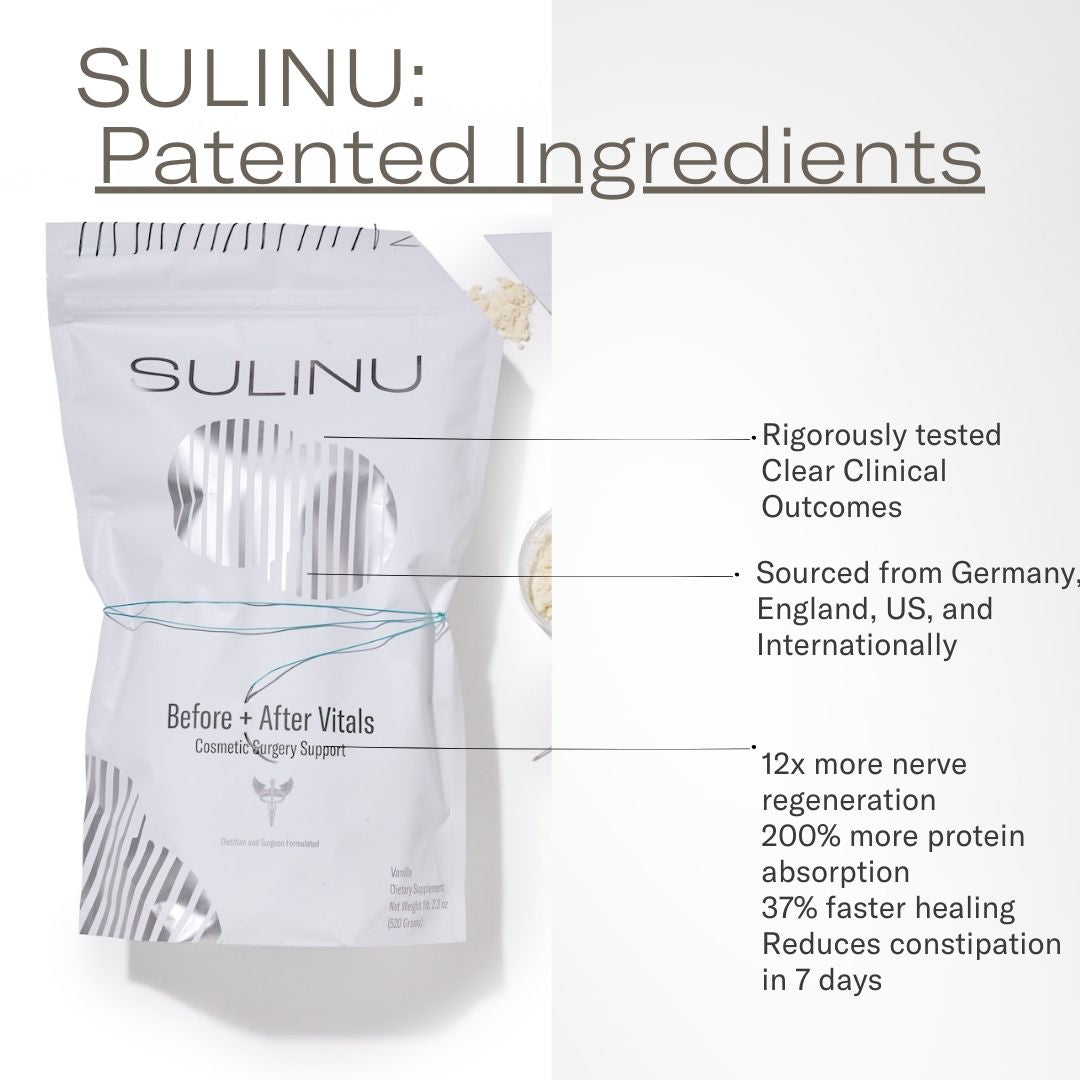
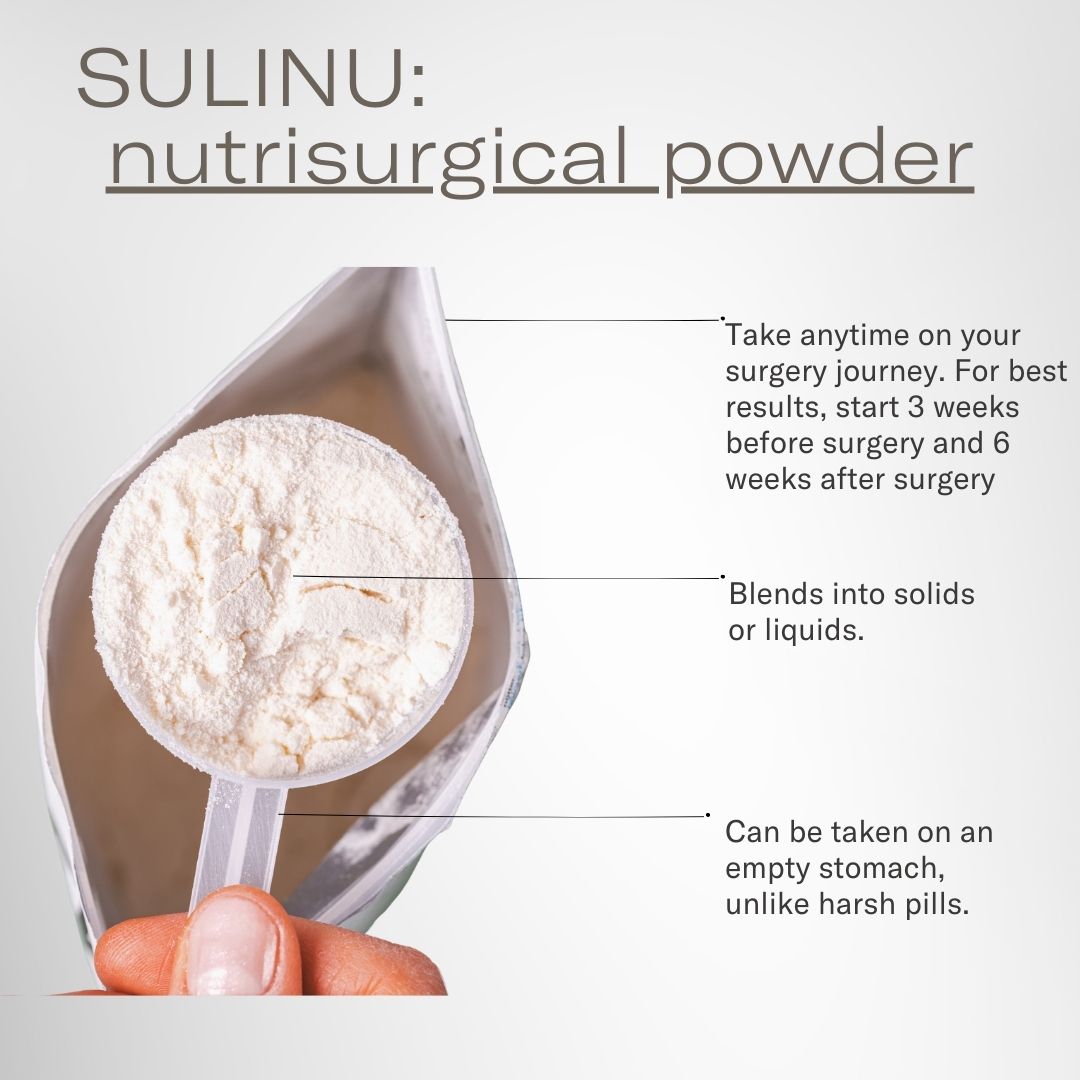
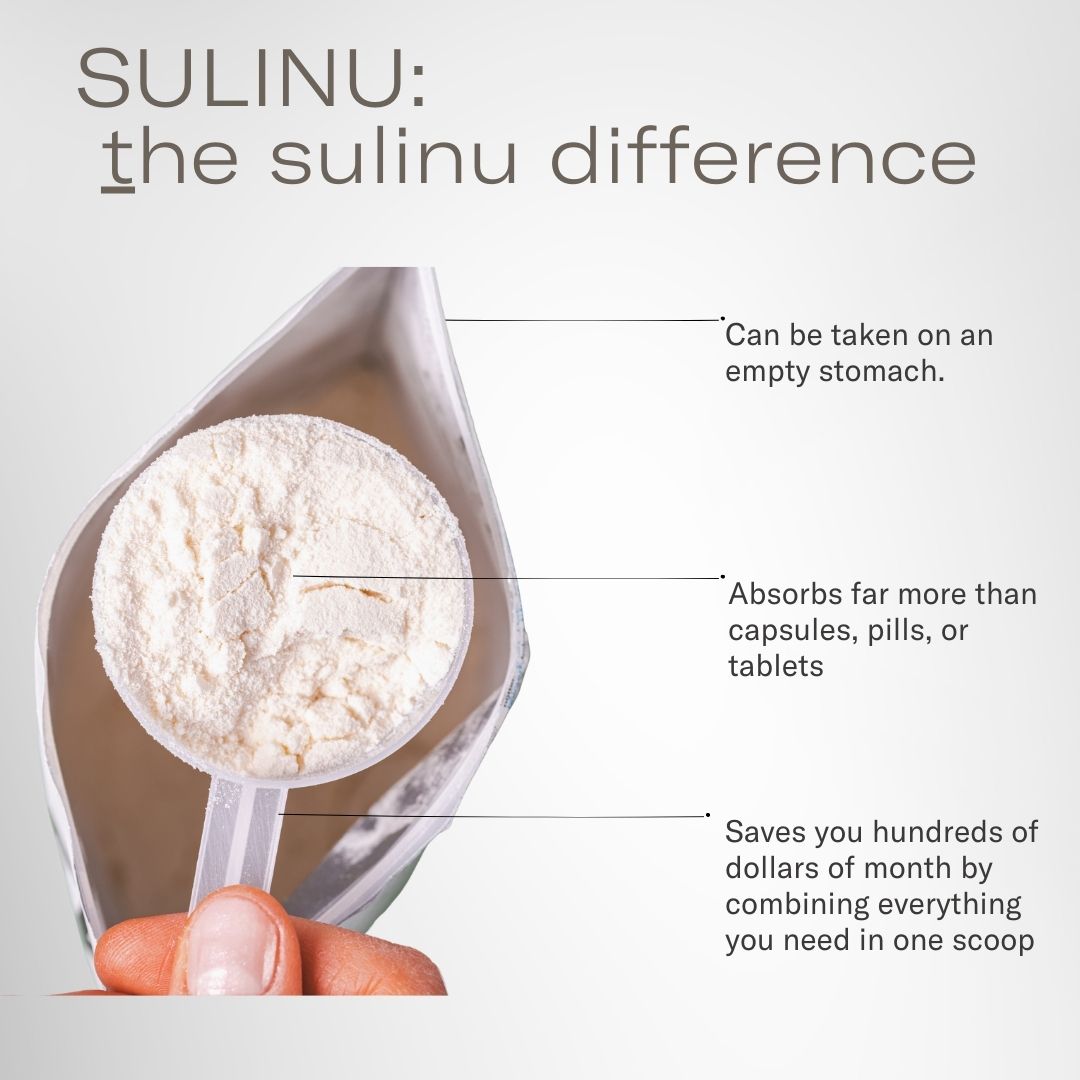
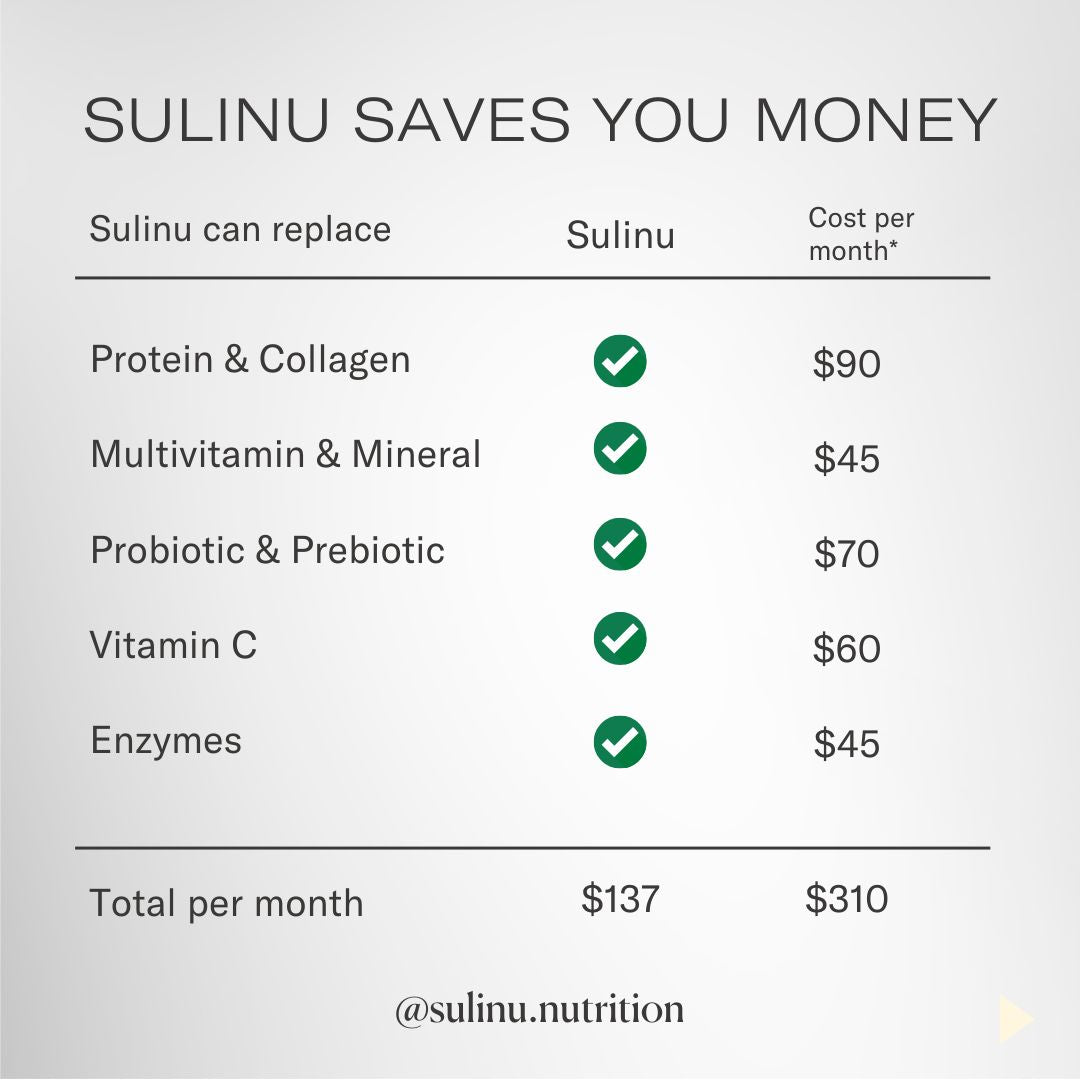
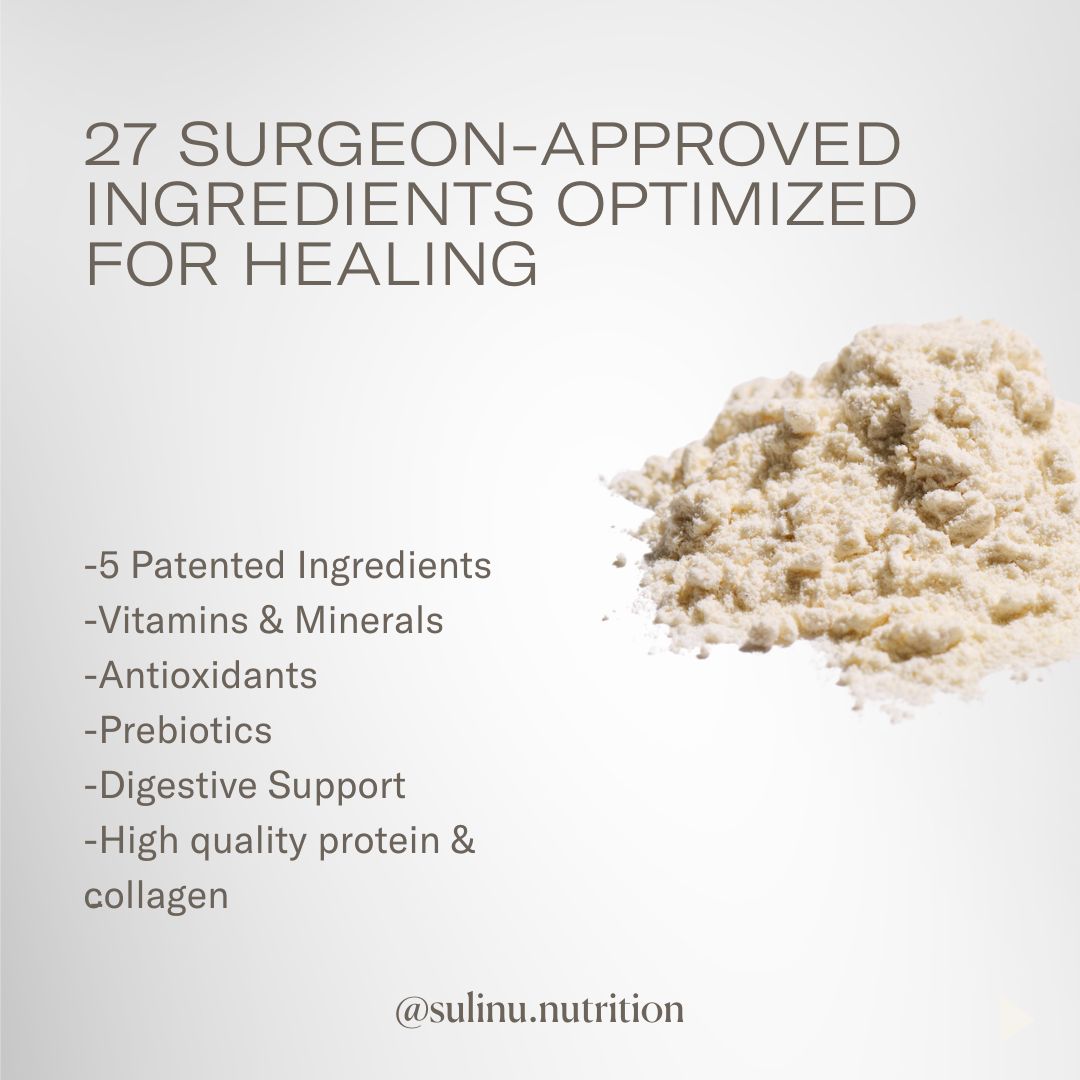
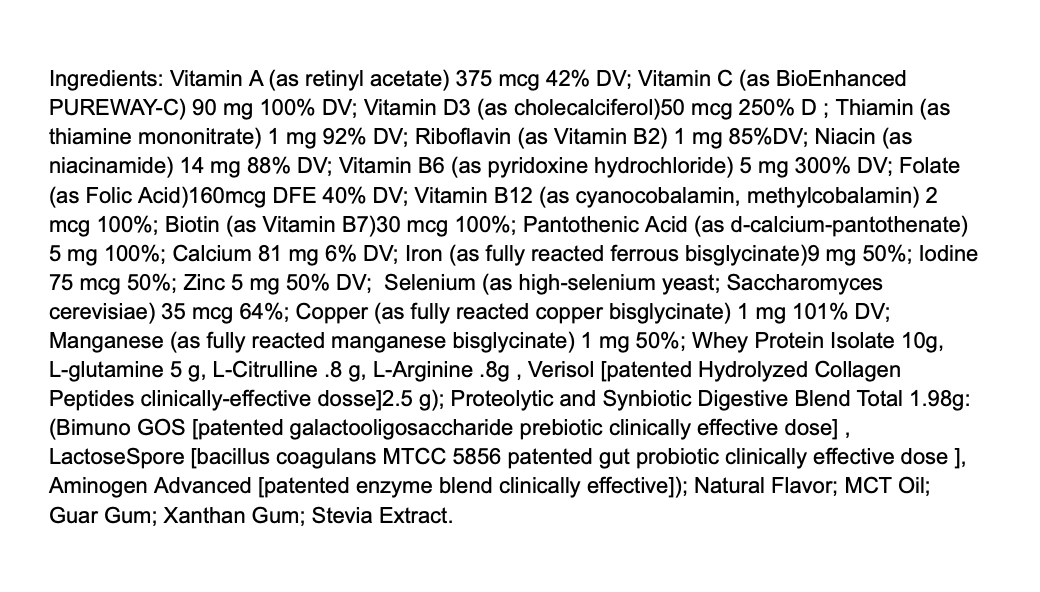
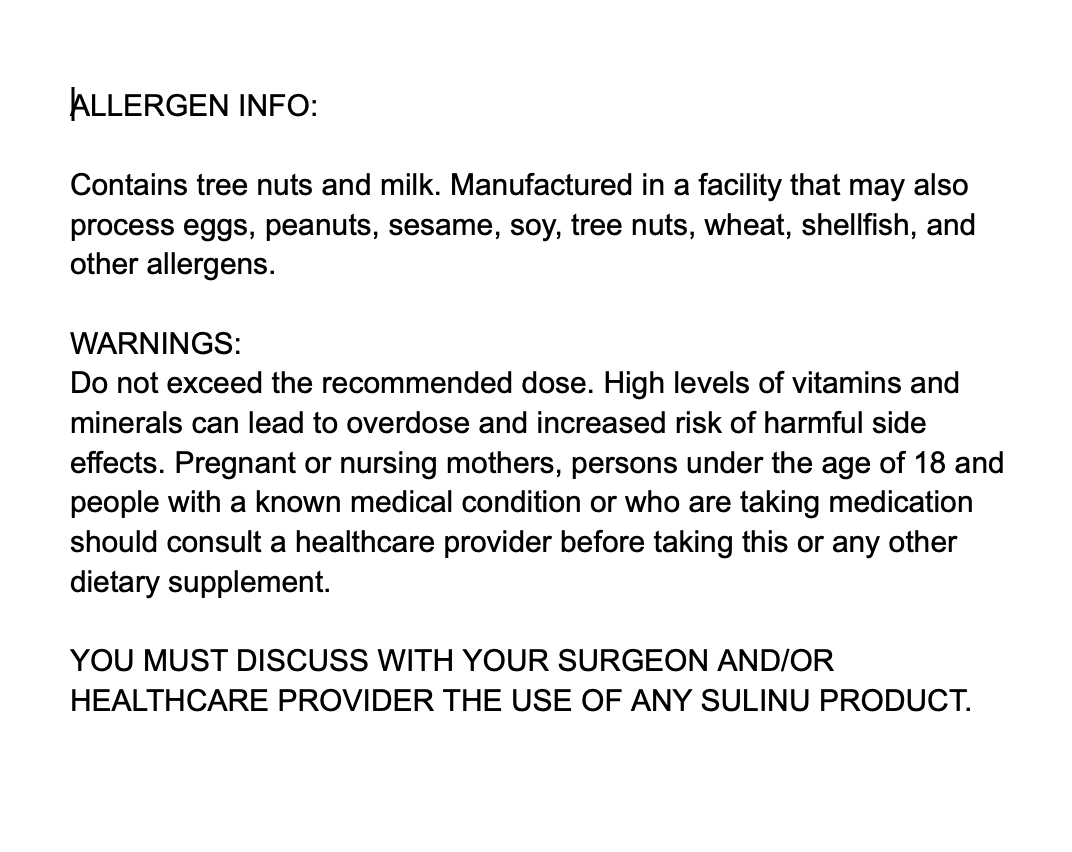

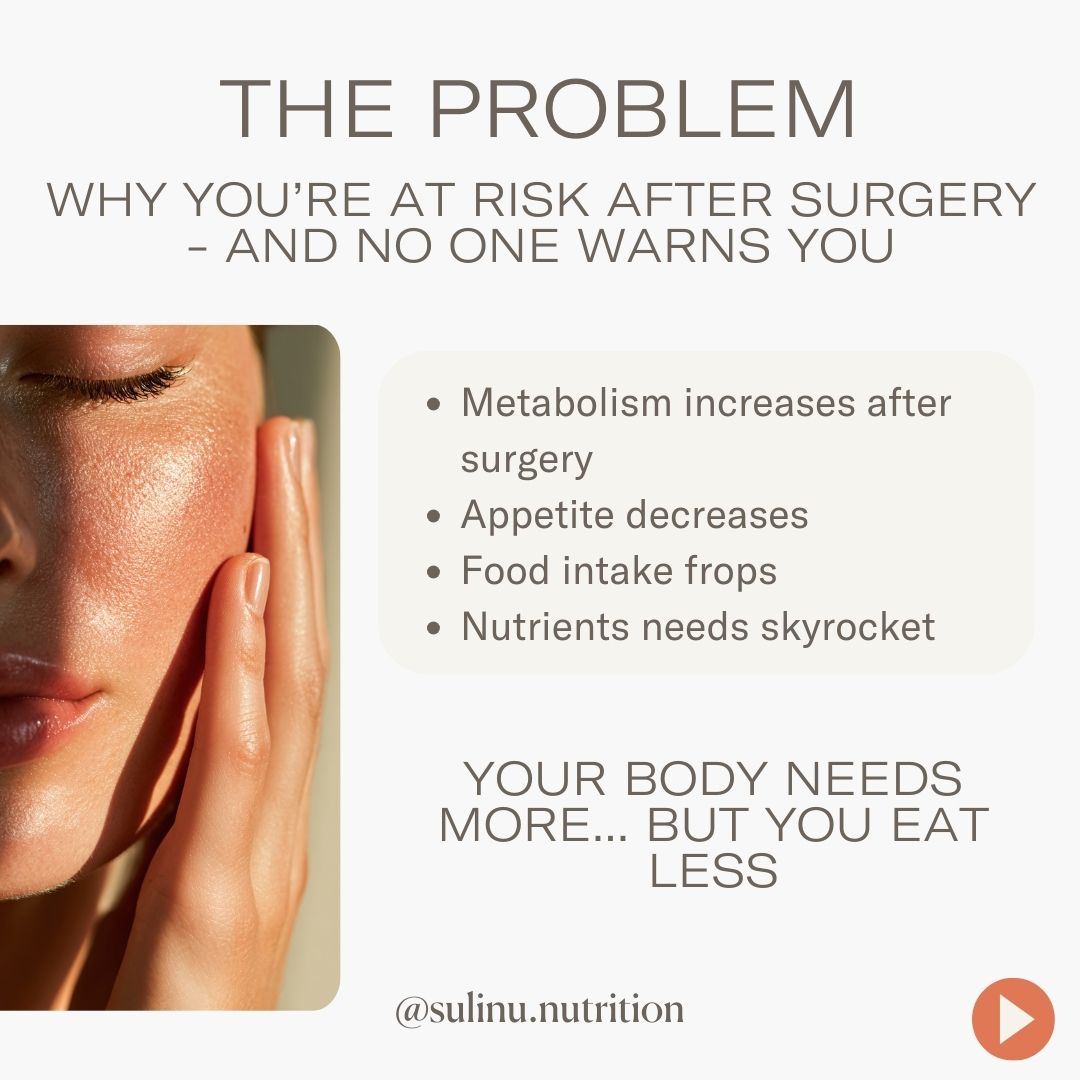
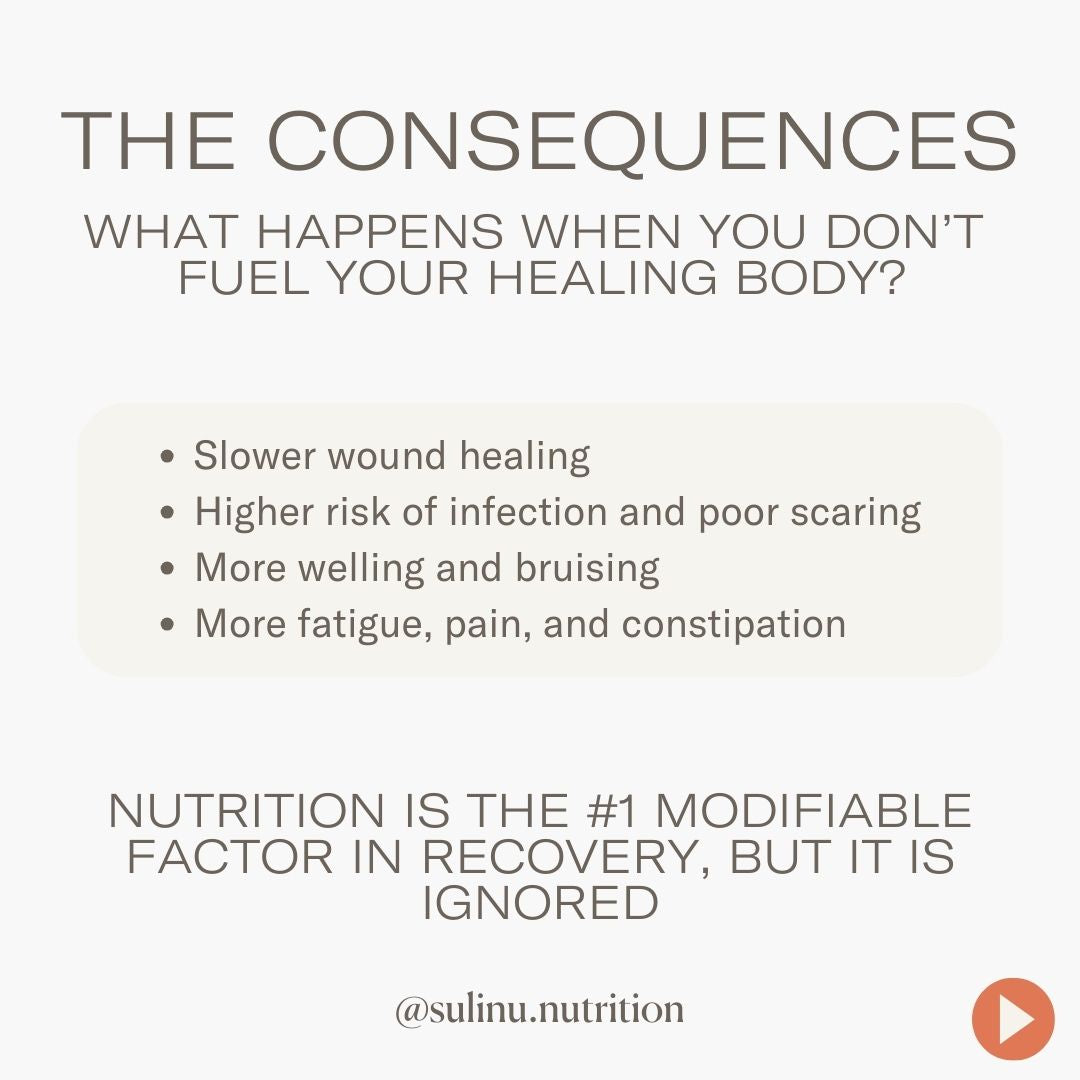
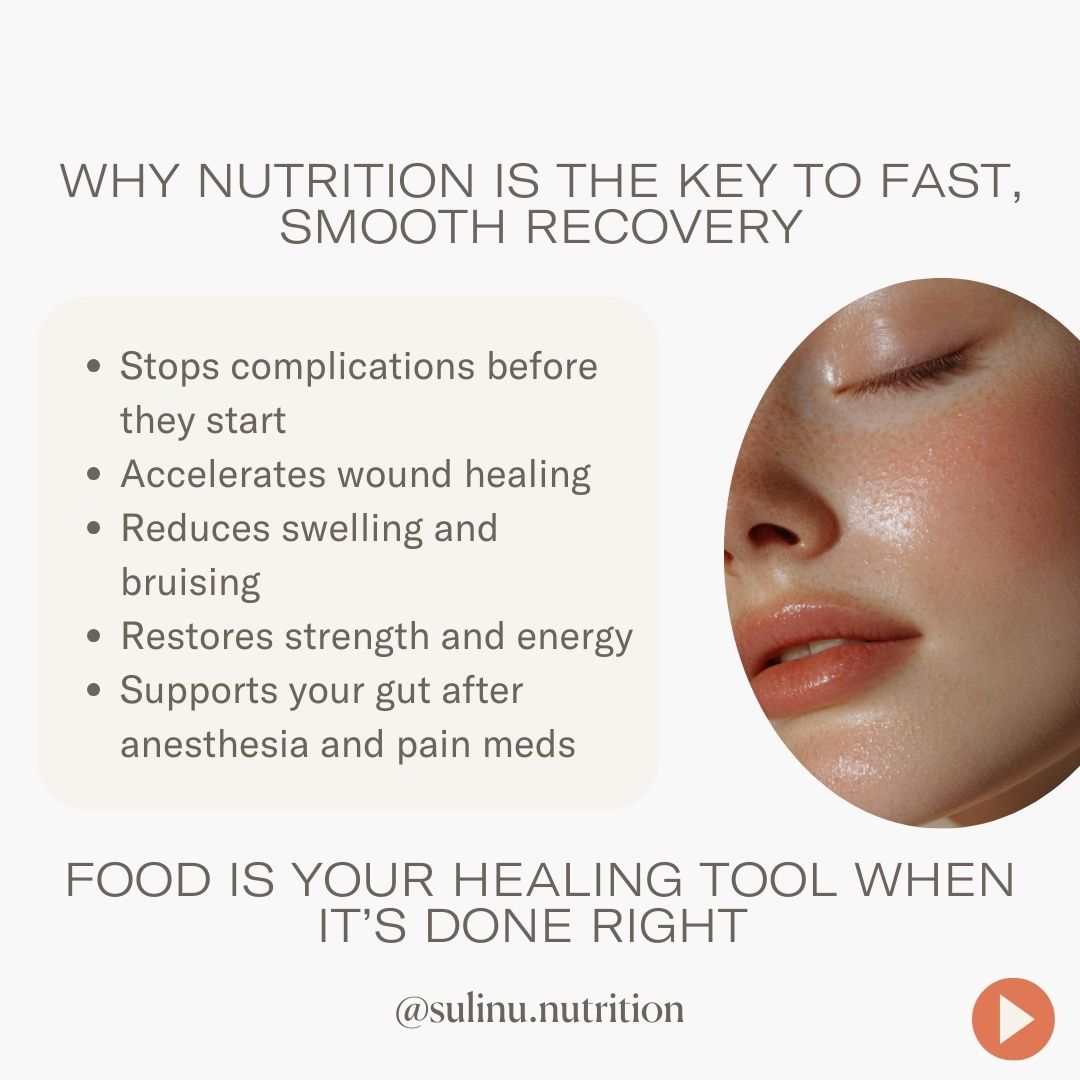
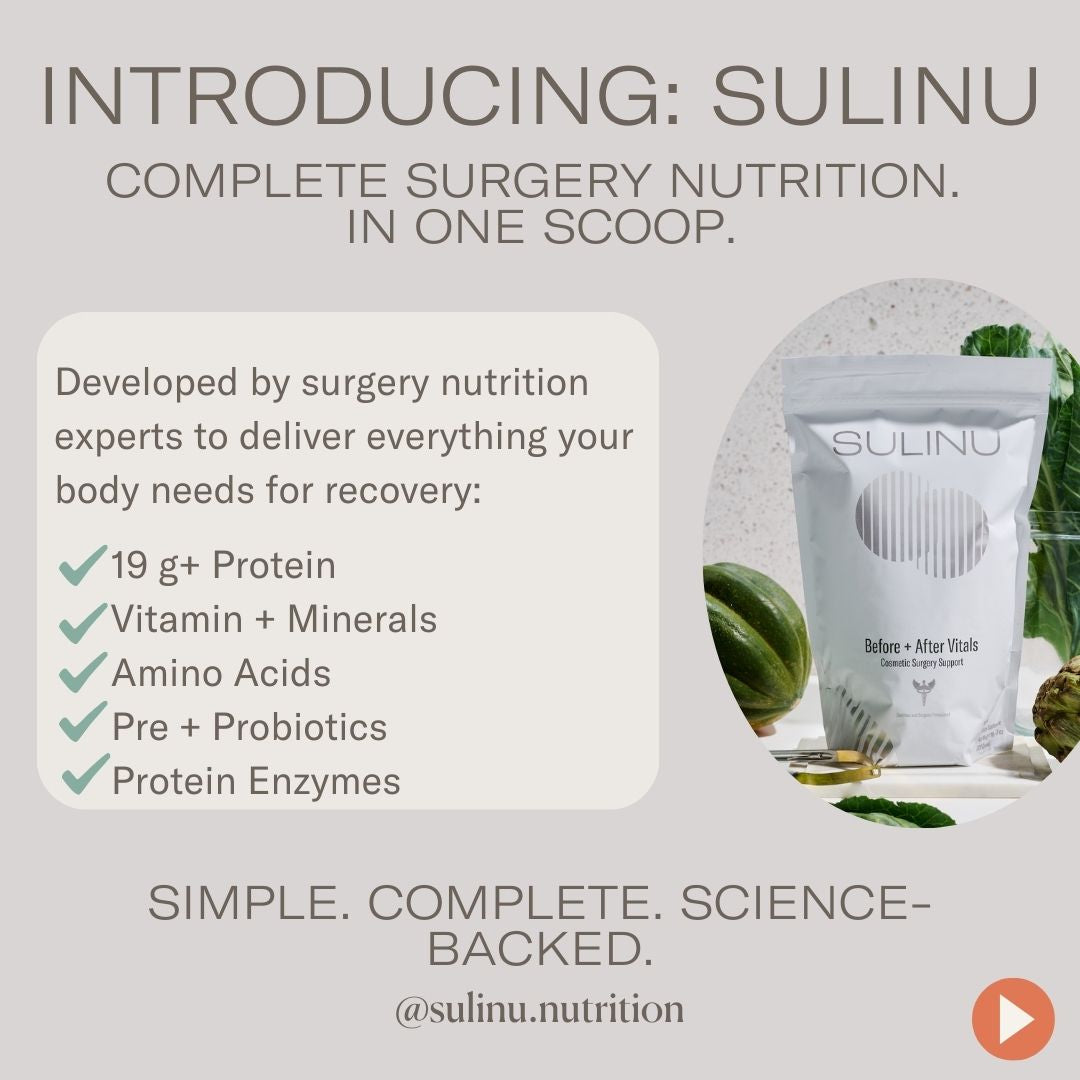
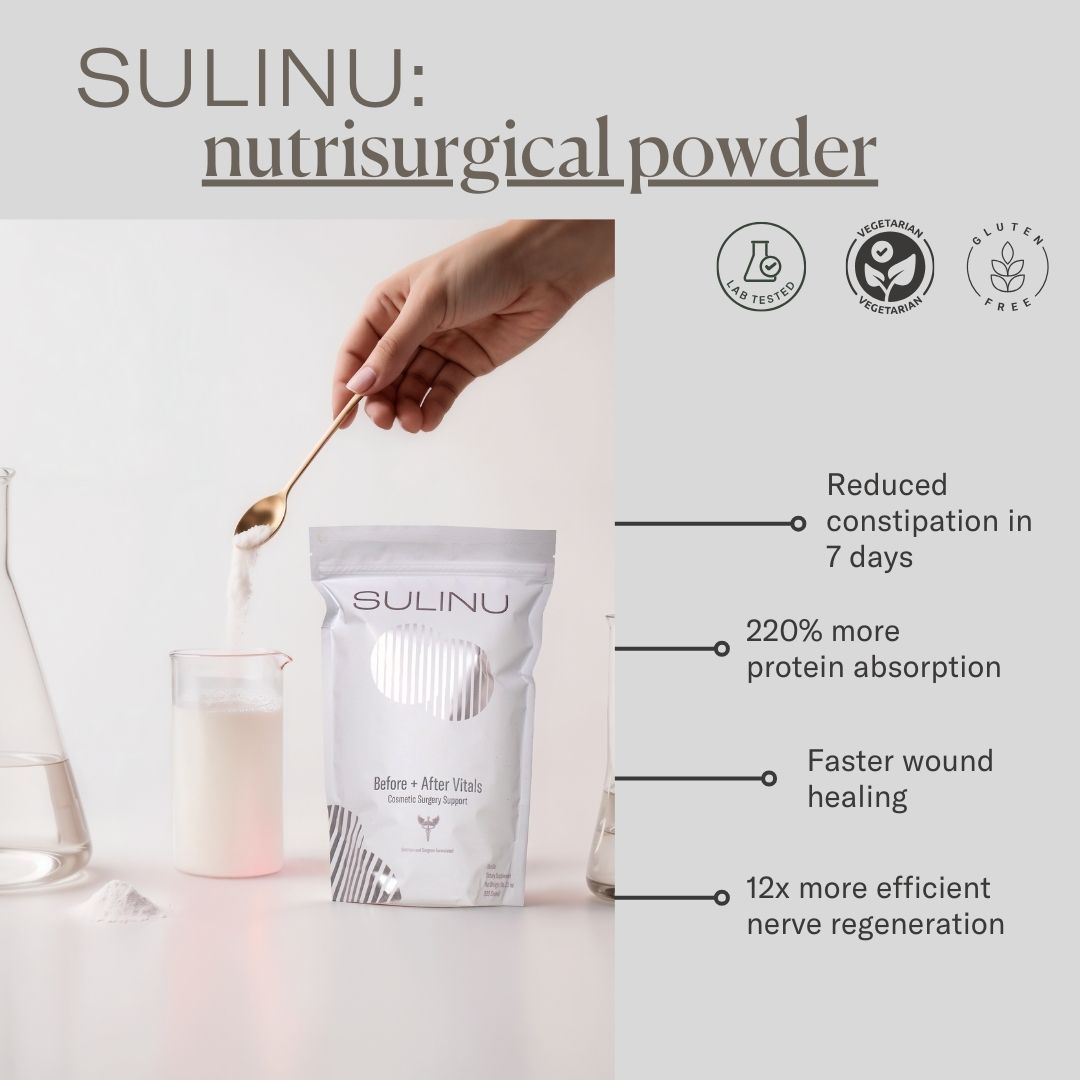
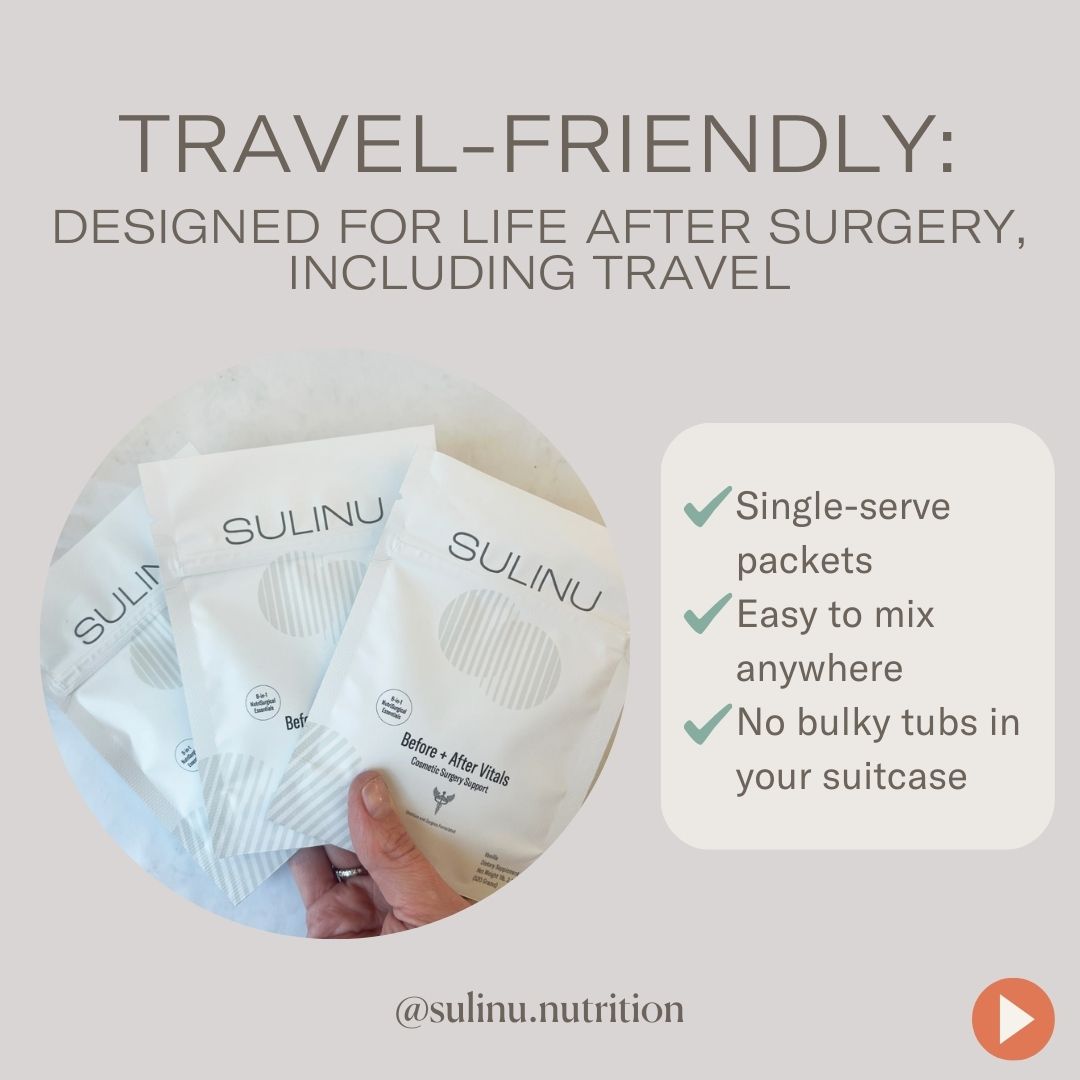
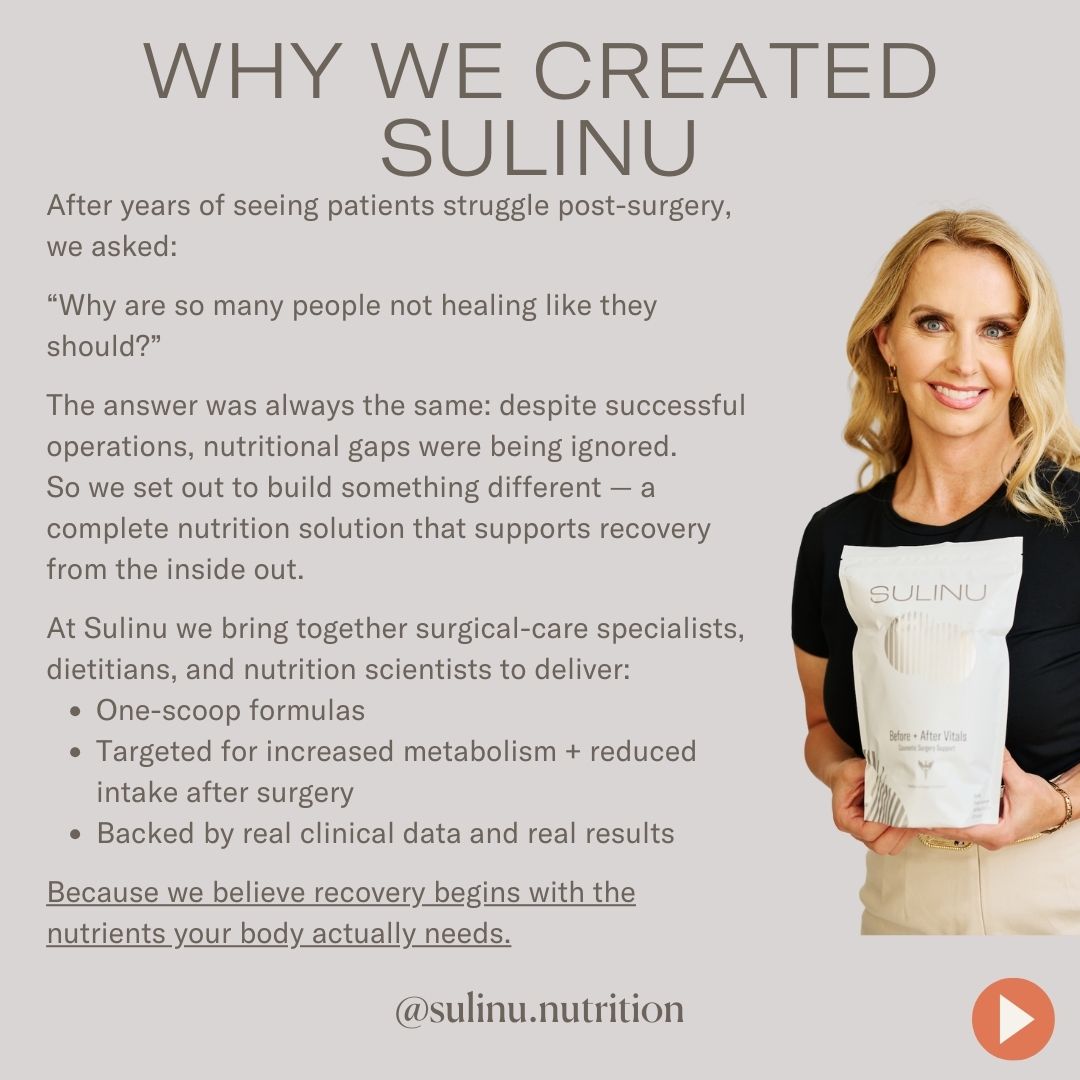
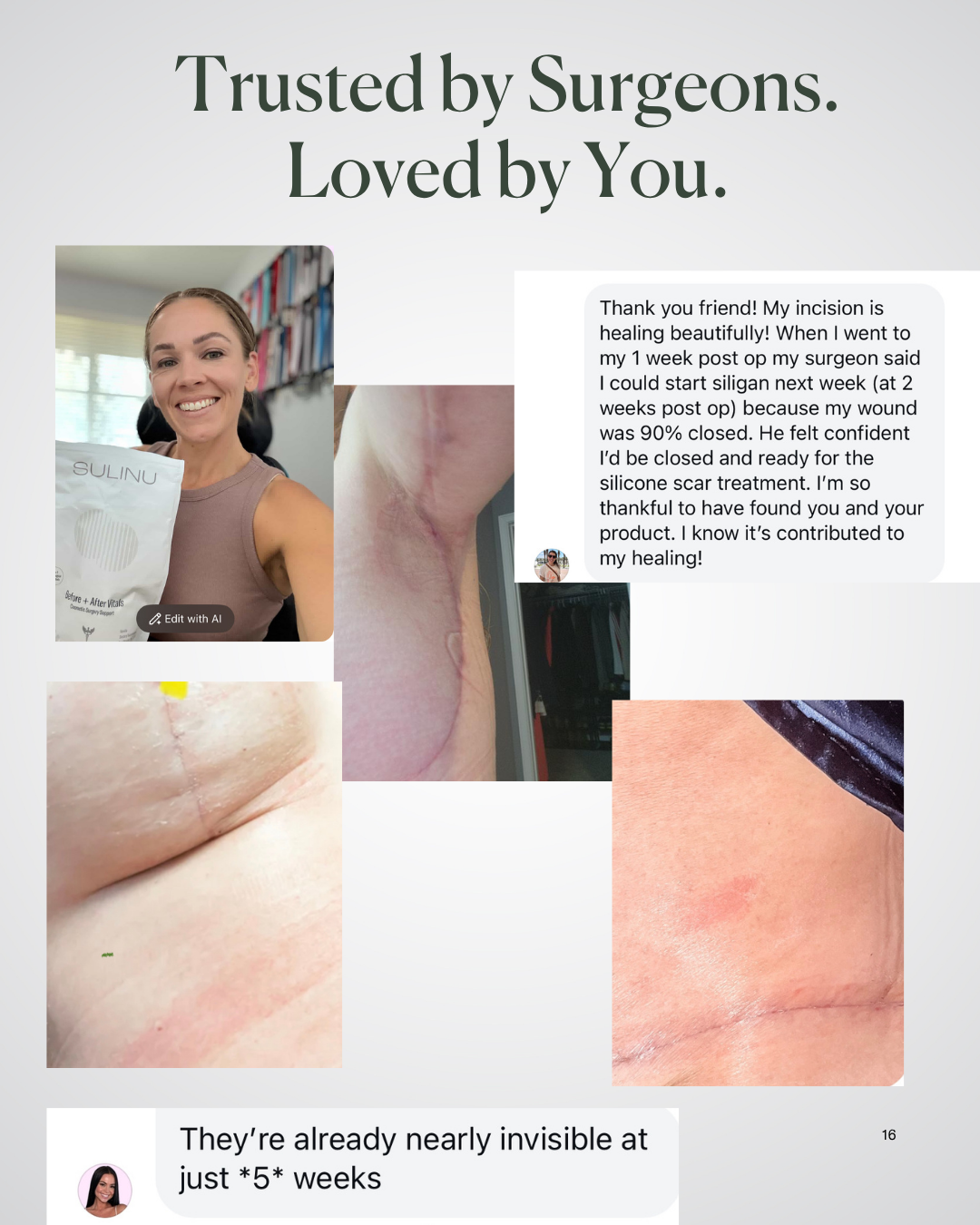
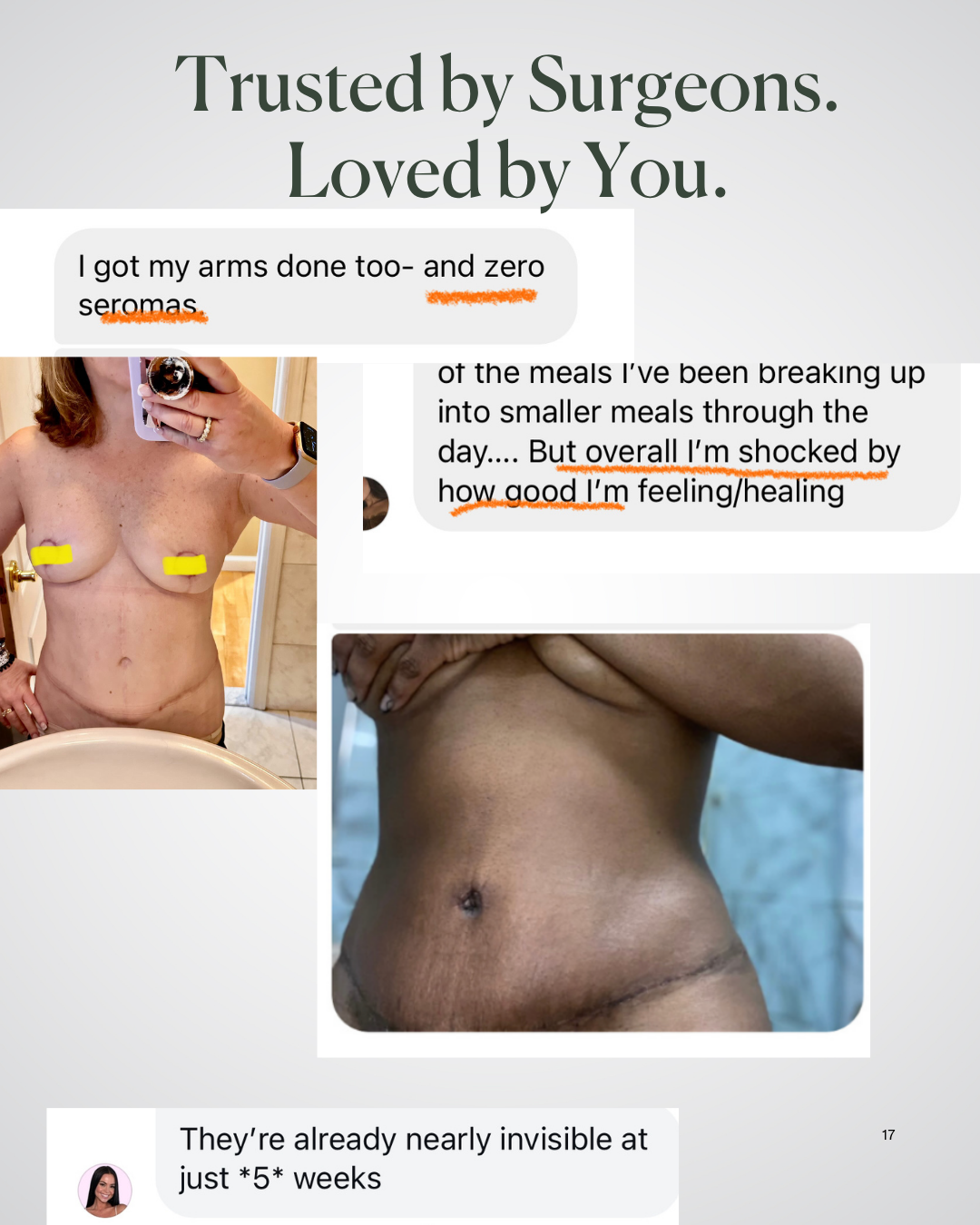
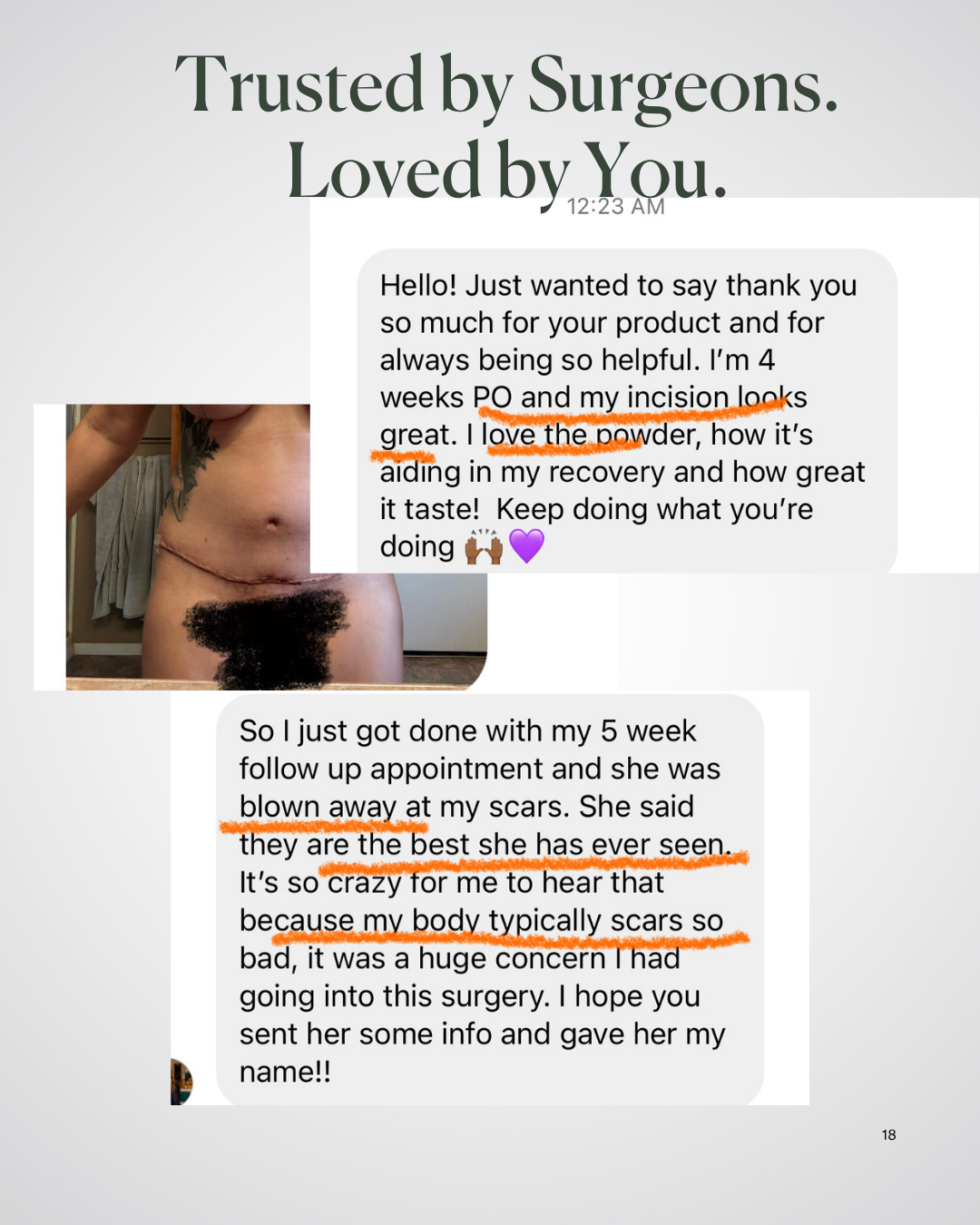
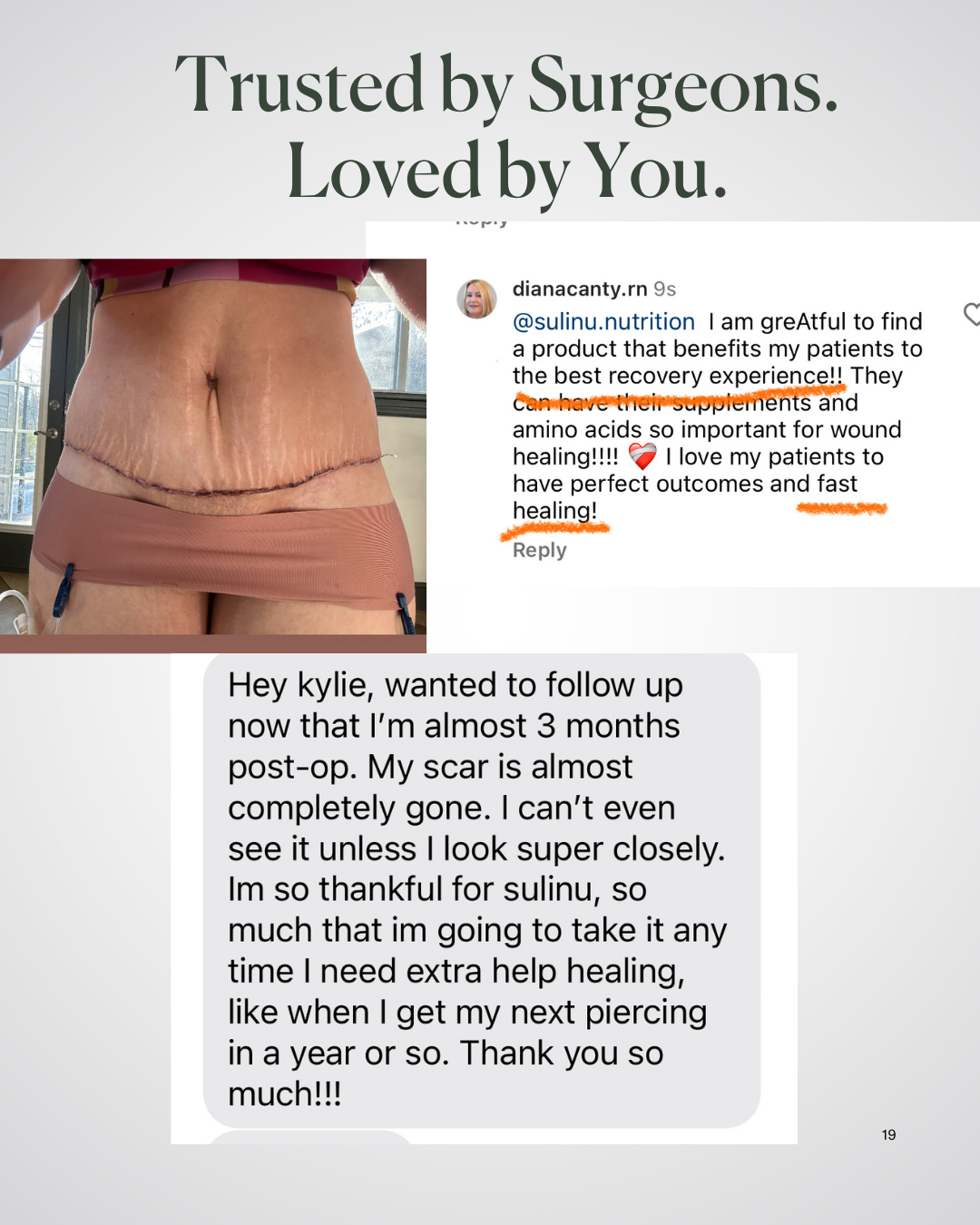
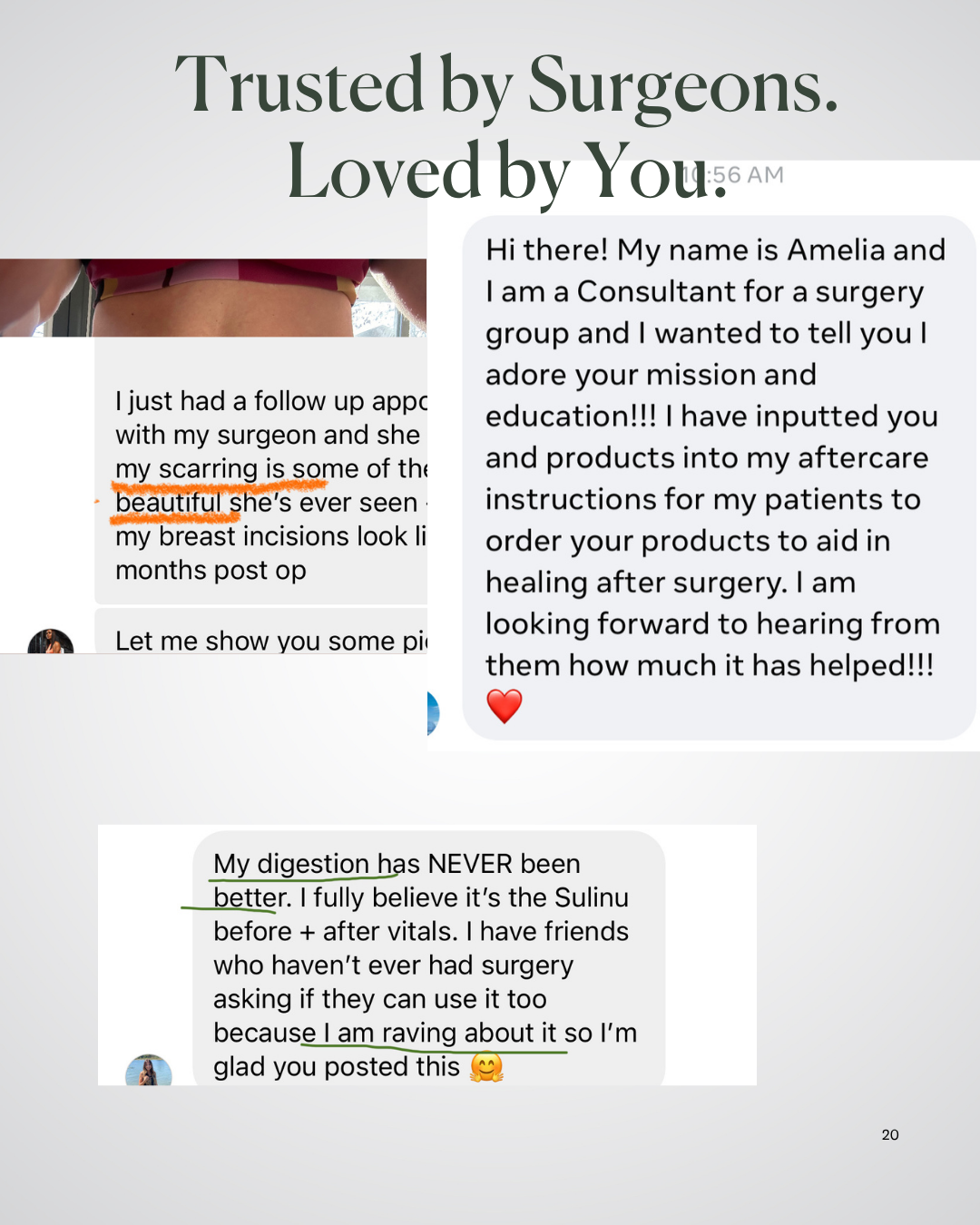
NUTRISURGICAL VITAMIN POWDER -(bag: Vanilla)
**FREE SHIPPING for orders over $150!!**
- 100% Money Back Guarantee
- Discreet Shipping-Your privacy is important
- We recommend 3 bags for any surgery for the best results
This Complete Surgery Powder gives you EVERYTHING you need IN ONE SCOOP.
Pre and Post Surgery Supplements for that near-invisible scar look.
"Can you believe it? [My incision scars] are nearly invisible at just 5 weeks!" -Jessie
Our pre and post surgery supplements are packed with vitamins for wound healing after surgery
- 3rd party tested
- Gluten-Free
- Vegetarian Whey
-
27 Surgeon-Approved Ingredients
- In bioavailable forms
-
5 Patented Ingredients
- Patented is the HIGHEST standard of ingredients
- Faster Incision healing
- Gut microbiome studied
- Clinically tested
- Sourced from Europe and Internationally
- Therapeutic Dosages
Perfect for:
- Before Cosmetic Surgery
- After Cosmetic Surgery
- Slow-to-heal incisions or wounds
- Using a GLP and needing extra nutrition
- Can begin taking at anytime on your surgery journey, EVEN if you are weeks after your surgery! Your scar is healing for a least a year after your surgery date.
How to use:
- Use 1/2 to 1 scoop a day. Max 1 scoop a day for at least 6 weeks postop.
- We recommend 3 bags: Use 1 bag before surgery and 2 bags after surgery
Nutrisurgical Vitamin Powder with Patented, Clinically-tested Ingredients.
All your Protein, Collagen, Amino Acids, MicroNutrients, Synbiotics and Enzymes in ONE SCOOP to give you a seamless recovery after cosmetic surgery.
Note: This product is also commonly used by GLP (Ozempic, Semiglutide, etc) patients to prevent nutrient depletion and Ozempic face
Our Survey Results*:
79% reported a beautiful incision
85% reported a faster recovery
90% liked the taste
X Gluten X Soy X Artificial Colors or Flavors X GMOs
*based upon our postop survey 2024
Introducing BEFORE + AFTER VITALS, the ultimate surgeon-endorsed nutritional supplement tailored exclusively for plastic surgery recovery.
Fears of infection, inflammation, slow-to-heal incisions, and bruising are taken head-on by this super fine, quick-to-dissolve powdered supplement. Add a delicious hit of vanilla flavor to your cold or warm drinks, smoothies, or culinary creations.
1 pouch is 20 servings.
ALLERGY info: Contains lactose. Product was processed in a facility that may also process eggs, peanuts, sesame, soy, tree nuts, shellfish, and other allergens.

